Note
as a fellow disabled (partially bed-bound) home cook, i wanted to ask – how are you able to cook complex recipes so often?
its really cool seeing your recipes, even if i am unable to make them myself (due to a garlic and onion allergy)
im a foodie and prefer to make more complex recipes, but i rarely have the energy to cook more than once a day. after i do, i often have to go lay down after i finish eating because im in pain from being upright, prepping vegetables, and washing dishes for too long. ive tried sitting down while doing the food prep process, but it hasnt helped much (apologies if that was tmi)
would you have any tips for cooking with chronic pain? thank you for your time!
I apologise for not answering this or the other few similar queries I've gotten until now. the subject is still slightly upsetting to me even now, a few years into my present level of capacity.
it's a combination of:
physical therapy & medication that have increased the amount of time that I can spend upright to a solid few hours a day
taking frequent breaks to lie down on the floor and let my shoulders / neck rest
labour-saving devices such as a kitchen mixer (or kneading dough with elbows or by putting it in a bag and stepping on it, when it's a quantity or type of dough that won't work in a stand mixer); food processor; &c.
giving frequent reminders to myself to relax my shoulders and take a few seconds to stretch. the expectation of pain can cause you to tense up, which can lead to more pain
unless there's a step that requires an hour of resting time or something, I do all the prep work first (good knife skills + keeping your knife sharp will help this be done with the minimal amount of time and force exerted)--then I can lie down for short intervals while something is stewing in between adding ingredients, &c.
willingness to bear a lot of pain in order to be able to do what I want to do (after a couple years of doing nothing in order to avoid pain you frankly just get bored)
the fact that it's my partner's job to wash the dishes (moment of silence for her)
I do always lie down after I'm finished eating regardless--unless I'm specifically doing something that absolutely requires me to be upright, I am lying down all day.
I don't often cook more than once a day, and some of what I cook for myself and my partner is simpler than much of what I post here (various dals and rice; lentil or squash soups; bibimbap; noodle stir-fries). recall that I only upload a new recipe once a week or so.
you may be interested in this ask about some of the less energy-intensive recipes I've uploaded over the years.
65 notes
·
View notes
Text

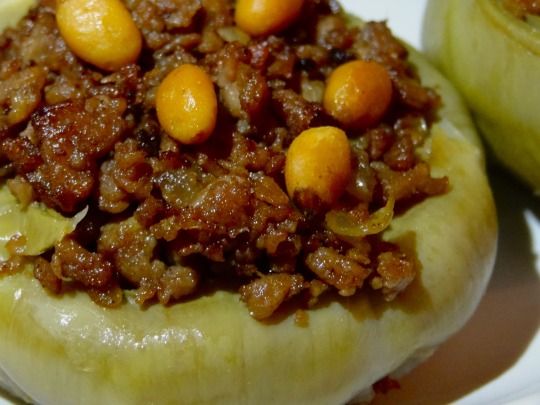
[ID: The first image is of four stuffed artichoke hearts on a plate with a mound of rice and fried vermicelli; the second is a close-up on one artichoke, showing fried ground 'beef' and golden pine nuts. End ID]
أرضي شوكي باللحم / Ardiyy-shawkiyy b-al-lahm (Stuffed artichoke hearts)
Artichoke hearts stuffed with spiced meat make a common dish throughout West Asia and North Africa, with variations on the recipe eaten in Lebanon, Syria, Palestine, Algeria, and Morocco. In Palestine, the dish is usually served on special occasions, either as an appetizer, or as a main course alongside rice. The artichokes are sometimes paired with cored potatoes, which are stuffed and cooked in the same manner. Stuffed artichokes do not appear in Medieval Arab cookbooks (though artichokes do), but the dish's distribution indicates that its origin may be Ottoman-era, as many other maḥshis (stuffed dishes) are.
The creation of this dish is easy enough once the artichoke hearts have been excavated (or, as the case may be, purchased frozen and thawed): they are briefly deep-fried, stuffed with ground meat and perhaps pine nuts, then stewed in water, or water and tomato purée, or stock, until incredibly tender.
While simple, the dish is flavorful and well-rounded. A squeeze of lemon complements the bright, subtle earthiness of the artichoke and cuts through the richness of the meat; the fried pine nuts provide a play of textures, and pick up on the slight nutty taste that artichokes are known for.
Terminology and etymology
Artichokes prepared in this way may be called "ardiyy-shawkiyy b-al-lahm." "Ardiyy-shawkiyy" of course means "artichoke"; "ب" ("b") means "with"; "ال" ("al") is the determiner "the"; and "لَحْم" ("laḥm") is "meat" (via a process of semantic narrowing from Proto-Semitic *laḥm, "food"). Other Palestinian Arabic names for the same dish include "أرضي شوكي محشي" ("ardiyy-shawkiyy maḥshi," "stuffed artichokes"), and "أرضي شوكي على ادامه" ("ardiyy-shawkiyy 'ala adama," "artichokes cooked in their own juice").
The etymology of the Levantine dialectical phrase meaning "artichoke" is interestingly circular. The English "artichoke" is itself ultimately from Arabic "الخُرْشُوف" ("al-khurshūf"); it was borrowed into Spanish (as "alcarchofa") during the Islamic conquest of the Iberian peninsula, and thence into English via the northern Italian "articiocco." The English form was probably influenced by the word "choke" via a process of phono-semantic matching—a type of borrowing wherein native words are found that sound similar to the foreign word ("phonetics"), and communicate qualities associated with the object ("semantics").
"Artichoke" then returned to Levantine Arabic, undergoing another process of phono-semantic matching to become "ardiyy-shawkiyy": أَرْضِيّ ("ʔarḍiyy") "earthly," from أَرْض ("ʔarḍ"), "Earth, land"; and شَوْكِيّ ("shawkiyy") "prickly," from شَوْك ("shawk"), "thorn."
Artichokes in Palestine
Artichoke is considered to be very healthful by Palestinian cooks, and it is recommended to also consume the water it is boiled in (which becomes delightfully savory and earthy, suitable as a broth for soup). In addition to being stuffed, the hearts may be chopped and cooked with meat or potatoes into a rich soup. These soups are enjoyed especially during Ramadan, when hot soup is popular regardless of the season—but the best season for artichokes in the Levant is definitively spring. Stuffed artichokes are thus often served by Jewish people in North Africa and West Asia during Passover.
Artichokes grow wild in Palestine, sometimes in fields adjacent to cultivated crops such as cereals and olives. Swiss traveler Johann Ludwig Burckhardt, writing in 1822, referred to the abundant wild artichoke plants (presumably Cynara syriaca) near لُوبْيا ("lūbyā"), a large village of stone buildings on a hilly landscape just west of طبريا ("ṭabariyya," Tiberias):
About half an hour to the N. E. [of Kefer Sebt (كفر سبط)] is the spring Ain Dhamy (عين ظامي), in a deep valley, from hence a wide plain extends to the foot of Djebel Tor; in crossing it, we saw on our right, about three quarters of an hour from the road, the village Louby (لوبي), and a little further on, the village Shedjare (شجره). The plain was covered with the wild artichoke, called khob (خُب); it bears a thorny violet coloured flower, in the shape of an artichoke, upon a stem five feet in height.
(Despite resistance from local militia and the Arab Liberation Army, Zionist military groups ethnically cleansed Lubya of its nearly 3,000 Palestinian Arab inhabitants in July of 1948, before reducing its buildings and wells to rubble, The Jewish National Fund later planted the Lavi pine forest over the ruins.)
Artichokes are also cultivated and marketed. Elihu Grant, nearly a century after Burckhardt's writing, noted that Palestinian villages with sufficient irrigation "[went] into gardening extensively," and marketed their goods in crop-poor villages or in city markets:
Squash, pumpkin, cabbage, cauliflower, lettuce, turnip, beet, parsnip, bean, pea, chick-pea, onion, garlic, leek, radish, mallow and eggplant are common varieties [of vegetable]. The buds of the artichoke when boiled make a delicious dish. Potatoes are getting to be quite common now. Most of them are still imported, but probably more and more success will be met in raising a native crop.
Either wild artichokes (C. syriaca) or cardoons (C. cardunculus, later domesticated to yield modern commerical artichokes) were being harvested and eaten by Jewish Palestinians in the 1st to the 3rd centuries AD (the Meshnaic Hebrew is "עַכָּבִיּוֹת", sg. "עַכָּבִית", "'aqubit"; related to the Arabic "عَكُوب" "'akūb," which refers to a different plant). The Tosefta Shebiit discusses how farmers should treat the sprouting of artichokes ("קינרסי," "qinrasi") during the shmita year (when fields are allowed to lie fallow), indicating that Jews were also cultivating artichokes at this time.
Though artichokes were persistently associated with wealth and the feast table (perhaps, Susan Weingarten speculates, because of the time they took to prepare), trimming cardoons and artichokes during festivals, when other work was prohibited, was within the reach of common Jewish people. Those in the "upper echelons of Palestinian Jewish society," on the other hand, had access to artichokes year-round, including (through expensive marvels of preservation and transport) when they were out of season.
Jewish life and cuisine
Claudia Roden writes that stuffed artichoke, which she refers to as "Kharshouf Mahshi" (خرشوف محشي), is "famous as one of the grand old Jerusalem dishes" among Palestinian Jews. According to her, the stuffed artichokes used to be dipped in egg and then bread crumbs and deep-fried. This breading and frying is still referenced, though eschewed, in modern Sephardi recipes.
Prior to the beginning of the first Aliyah (עלייה, wave of immigration) in 1881, an estimated 3% of the overall population of Palestine, or 15,011 people, were Jewish. This Jewish presence was not the result of political Zionist settler-colonialism of the kind facilitated by Britain and Zionist organizations; rather, it consisted of ancestrally Palestinian Jewish groups, and of refugees and religious immigrants who had been naturalized over the preceding decades or centuries.
One such Jewish community were the Arabic-speaking Jews whom the Sephardim later came to call "מוּסְתערבים" or "مستعربين" ("Musta'ravim" or "Musta'ribīn"; from the Arabic "مُسْتَعْرِب" "musta'rib," "Arabized"), because they seemed indifferentiable from their Muslim neighbors. A small number of them were descendants of Jews from Galilee, which had had a significant Jewish population in the mid-1st century BC; others were "מגרבים" ("Maghrebim"), or "مغربية" ("Mughariba"): descendents of Jews from Northwest Africa.
Another major Jewish community in pre-mandate Palestine were Ladino-speaking descendents of Sephardi Jews, who had migrated to Palestine in the decades following their expulsion from Spain and then Portugal in the late 15th century. Though initially seen as foreign by the 'indigenous' Mista'avim, this community became dominant in terms of population and political influence, coming to define themselves as Ottoman subjects and as the representatives of Jews in Palestine.
A third, Yiddish- and German-speaking, Askenazi Jewish population also existed in Palestine, the result of immigration over the preceding centuries (including a large wave in 1700).
These various groups of Jewish Palestinians lived as neighbors in urban centers, differentiating themselves from each other partly by the language they spoke and partly by their dress (though Sephardim and Ashkenazim quickly learned Arabic, and many Askenazim and Muslims learned Ladino). Ashkenazi women also learned from Sephardim how to prepare their dishes. These groups' interfamiliarity with each other's cuisine is further evidenced by the fact that Arabic words for Palestinian dishes entered Ladino and Yiddish (e.g. "كُفْتَة" / "kufta," rissole; "مَزَّة" "mazza," appetizer); and words entered Arabic from Ladino (e.g. "דונסי" "donsi," sweet jams and fruit leather; "בוריק" "burek," meat and cheese pastries; "המים" "hamim," from "haminados," braised eggs) and Yiddish (e.g. "לעקעך" "lakach," honey cake).
In addition to these 'native' Jews were another two waves of Ashkenazi migration in the late 18th and early-to-mid 19th centuries (sometimes called the "היישוב הישן," "ha-yishuv ha-yashan," "old settlement," though the term is often used more broadly); and throughout the previous centuries there had also been a steady trickle of religious immigration, including elderly immigrants who wished to die in Jerusalem in order to be present at the appointed place on the day of Resurrection. Recent elderly women immigrants unable to receive help from charitable institutions would rely on the community for support, in exchange helping the young married women of the neighborhood with childcare and with the shaping of pastries ("מיני מאפה").
In the first few centuries AD, the Jewish population of Palestine were largely farmers and agricultural workers in rural areas. By the 16th century, however, most of the Jewish population resided in the Jewish Holy Cities of Jerusalem (القُدس / al-quds), Hebron (الخليل / al-khalil), Safed (صفد), and Tiberias (طبريا / ṭabariyya). In the 19th century, the Jewish population lived entirely in these four cities and in expanding urban centers Jaffa and Haifa, alongside Muslims and Christians. Jerusalem in particular was majority Jewish by 1880.
In the 19th century, Jewish women in Jerusalem, like their Christian and Muslim neighbors, used communal ovens to bake the bread, cakes, matzah, cholent, and challah which they prepared at home. One woman recalls that bread would be sent to the baker on Mondays and Thursdays—but bribes could be offered in exchange for fresh bread on Shabbat. Charges would be by the item, or else a fixed monthly payment.
Trips to the ovens became social events, as women of various ages—while watching the bakers, who might not put a dish in or take it out in time—sent up a "clatter" of talking. During religious feast days, with women busy in the kitchen, some families might send young boys in their stead.
Markets and bakeries in Jerusalem sold bread of different 'grades' based on the proportion of white and wheat flour they contained; as well as flatbread (خبز مفرود / חובז מפרוד / khobbiz mafroud), Moroccan מאווי' / ماوي / meloui, and semolina breads (כומאש / كماج / kmaj) which Maghrebim especially purchased for the Sabbath.
On the Sabbath, those who had brick ovens in their sculleries would keep food, and water for tea and coffee, warm from the day before (since religious law prohibits performing work, including lighting fires, on Shabbat); those who did not would bring their food to the oven of a neighbor who did.
Palestinian Jewish men worked in a variety of professions: they were goldsmiths, writers, doctors, merchants, scientists, linguists, carpenters, and religious scholars. Jewish women, ignoring prohibitions, engaged in business, bringing baked goods and extra dairy to markets in Jerusalem, grinding and selling flour, spinning yarn, and making clothing (usually from materials purchased from Muslims); they were also shopkeepers and sellers of souvenirs and wine. Muslims, Jews, and Christians shared residential courtyards, pastimes, commercial enterprises, and even holidays and other religious practices.
Zionism and Jewish Palestinians
Eastern European Zionists in the 1880s and 90s were ambivalent towards existing Jewish communities in Palestine, often viewing them as overly traditional and religious, backwards-thinking, and lacking initiative. Jewish Palestinians did not seem to conform with the land-based, agricultural, and productivist ideals of political Zionist thinkers; they were integrated into the Palestinian economy (rather than seeking to create their own, segregated one); they were not working to create a Jewish ethnostate in Palestine, and seemed largely uninterested in nationalist concerns. Thus they were identified with Diaspora Jewish culture, which was seen as a remnant of exile and oppression to be eschewed, reformed, or overthrown.
These attitudes were applied especially to Sephardim and Mista'arevim, who were frequently denigrated in early Zionist literature. In 1926, Revisionist Zionist leader Vladimir Jabotinsky wrote that the "Jews, thank God, have nothing in common with the East. We must put an end to any trace of the Oriental spirit in the Jews of Palestine." The governance of Jewish communities was, indeed, changed with the advent of the British Mandate (colonial rule which allowed the British to facilitate political Zionist settling), as European political and "socialist" Zionists promoted Ashkenazi over Sephardi leadership.
Under the Ottomans, the millet system had allowed a degree of Jewish and Christian autonomy in matters of religious study and leadership, cultural and legal affairs, and the minting of currency. The religious authority of all Jewish people in Palestine had been the Sephardi Rabbi of Jerusalem, and his authority on matters of Jewish law (like the authority of the Armenian Patriarchate on matters of Christian law) extended outside of Palestine.
But British and European funding allowed newer waves of Ashkenazi settlers (sometimes called "היישוב החדש," "ha-yishuv ha-khadash," "new settlement")—who, at least if they were to live out the ideals of their sponsors, were more secular and nationalist-minded than the prior waves of Ashkenazi immigration—to be de facto independent of Sephardi governance. Several factors lead to the drying up of halaka (donated funds intended to be used for communal works and the support of the poor in Sephardi communities), which harmed Sephardim economically.
Zionist ideas continued to dominate newly formed committees and programs, and Palestinian and Sephardi Jews reported experiences of racial discrimination, including job discrimination, leading to widespread poverty. The "Hebrew labor" movement, which promoted a boycott of Palestinian labor and produce, in fact marginalized all workers racialized as Arab, and promises of work in Jewish labor unions were divided in favor of Ashkenazim to the detriment of Sephardim and Mizrahim. This economic marginalization coincided with the "social elimination of shared indigenous [Palestinian] life" in the Zionist approach to indigenous Jews and Muslims.
Despite the adversarial, disdainful, and sometimes abusive relationship which the European Zionist movement had with "Oriental" Jews, their presence is frequently used in Zionist food and travel writing to present Israel as a multicultural and pluralist state. Dishes such as stuffed artichokes are claimed as "Israeli"—though they were eaten by Jews in Palestine prior to the existence of the modern state of Israel, and though Sephardi and Mizrahi diets were once the target of a civilizing, correcting mission by Zionist nutritionists. The deep-frying that stuffed artichokes call for brings to mind European Zionists' half-fascinated, half-disgusted attitudes towards falafel.
The point is not to claim a dish for any one national or ethnic group—which is, more often than not, an exercise in futility and even absurdity—but to pay attention to how the rhetoric of food writing can obscure political realities and promote the colonizer's version of history. The sinking of Jewish Palestinian life prior to the advent of modern political Zionism, and the corresponding insistence that it was Israel that brought "Jewish cuisine" to Palestine, allow for such false dichotomies as "Jewish-Palestinian relations" or "Jewish-Arab relations"; these descriptors further Zionist rhetoric by making a clear situation of ethnic cleansing and settler-colonialism sound like a complex and delicate issue of inter-ethnic conflict. To boot, the presentation of these communities as having merely paved the way to Zionist nationalism ignores their existence as groups with their own political, social, and cultural lives and histories.
Help evacuate a Gazan family with Operation Olive Branch
Buy an eSim for use in Gaza
Help Anera provide food in Gaza
Ingredients:
Serves 4 (as a main dish).
For the artichokes:
6 fresh, very large artichokes; or frozen (not canned) whole artichoke hearts
1 lemon, quartered (if using fresh artichokes)
250g (1 1/2 cups) vegetarian ground beef substitute; or 3/4 cup TVP hydrated with 3/4 cup vegetarian 'beef' stock from concentrate
1 yellow onion, minced
Scant 1/2 tsp kosher salt
1/2 tsp ground black pepper
1 pinch ground cardamom (optional)
1/4 tsp ground allspice or seb'a baharat (optional)
1 Tbsp pine nuts (optional)
Water, to simmer
Oil, to fry
2 tsp vegetarian 'beef' stock concentrate, to simmer (optional)
Lemon, to serve
Larger artichokes are best, to yield hearts 3-4 inches in width once all leaves are removed. If you only have access to smaller artichokes, you may need to use 10-12 to use up all the filling; you might also consider leaving some of the edible internal leaves on.
The meat may be spiced to taste. Sometimes only salt and black pepper are used; some Palestinian cooks prefer to include seb'a baharat, white pepper, allspice, nutmeg, cardamom, and/or cinnamon.
Medieval Arab cookbooks sometimes call for vegetables to be deep-fried in olive oil (see Fiḍālat al-Khiwān fī Ṭayyibāt al-Ṭaʿām wa-l-Alwān, chapter 6, recipe no. 373, which instructs the reader to treat artichoke hearts this way). You may use olive oil, or a neutral oil such as canola or sunflower (as is more commonly done in Palestine today).
Elihu Grant noted in 1921 that lemon juice was often served with stuffed vegetable dishes; today stuffed artichokes are sometimes served with lemon.
For the rice:
200g Egyptian rice (or substitute any medium-grained white rice)
2 tsp broken semolina vermicelli (شعيريه) (optional)
1 tsp olive oil (optional)
Large pinch salt
520g water, or as needed
Broken semolina vermicelli (not rice vermicelli!) can be found in plastic bags at halal grocery stores.
Instructions:
For the stuffed artichokes:
1. Prepare the artichoke hearts. Cut off about 2/3 of the top of the artichoke (I find that leaving at least some of the stem on for now makes it easier to hollow out the base of the artichoke heart without puncturing it).
2. Pull or cut away the tough outer bracts ("leaves") of the artichoke until you get to the tender inner leaves, which will appear light yellow all the way through. As you work, rub a lemon quarter over the sides of the artichoke to prevent browning.
3. If you see a sharp indentation an inch or so above the base of the artichoke, use kitchen shears or a sharp knife to trim off the leaves above it and form the desired bowl shape. Set aside trimmings for a soup or stew.
4. Use a small spoon to remove the purple leaves and fibers from the center of the artichoke. Make sure to scrape the spoon all along the bottom and sides of the artichoke and get all of the fibrous material out.
5. Use a paring knife to remove any remaining tough bases of removed bracts and smooth out the base of the artichoke heart. Cut off the entire stem, so that the heart can sit flat, like a bowl.
6. Place the prepared artichoke heart in a large bowl of water with some lemon juice squeezed into it. Repeat with each artichoke.
7. Drain artichoke hearts and pat dry. Heat a few inches of oil in a pot or wok on medium and fry artichoke hearts, turning over occasionally, for a couple minutes until lightly browned. If you don't want to deep-fry, you can pan-fry in 1 cm or so of oil, flipping once. Remove with a slotted spoon and drain.
8. Prepare the filling. Heat 1 tsp of olive oil in a large skillet on medium-high and fry onions, agitating often, until translucent.
Tip: Some people add the pine nuts and brown them at this point, to save a step later. If you do this, they will of course be mixed throughout the filling rather than being a garnish on top.
9. Add spices, salt, and meat substitute and fry, stirring occasionally, until meat is browned. (If using TVP, brown it by allowing it to sit in a single layer undisturbed for 3-4 minutes, then stir and repeat.) Taste and adjust spices and salt.
10. Heat 1 Tbsp of olive oil or margarine in a small pan on medium-low. Add pine nuts and fry, stirring constantly, until they are a light golden brown, then remove with a slotted spoon. Note that, once they start taking on color, they will brown very quickly and must be carefully watched. They will continue to darken after they are removed from the oil, so remove them when they are a shade lighter than desired.
11. Stuff the artichoke hearts. Fill the bowl of each heart with meat filling, pressing into the bottom and sides to fill completely. Top with fried pine nuts.
12. Cook the artichoke hearts. Place the stuffed artichoke hearts in a single layer at the bottom of a large stock pot, along with any extra filling (or save extra filling to stuff peppers, eggplant, zucchini, or grape leaves).
13. Whisk stock concentrate into several cups of just-boiled water, if using—if not, whisk in about a half teaspoon of salt. Pour hot salted water or stock into the pot to cover just the bottoms of the stuffed artichokes.
14. Simmer, covered, for 15-20 minutes, until the artichokes are tender. Simmer uncovered for another 5-10 minutes to thicken the sauce.
For the rice:
1. Rinse your rice once by placing it in a sieve, putting the sieve in a closely fitting bowl, then filling the bowl with water; rub the rice between your fingers to wash, and remove the sieve from the bowl to strain.
2. Place a bowl on a kitchen scale and tare. Add the rice, then add water until the total weight is 520g. (This will account for the amount of water stuck to the rice from rinsing.)
3. (Optional.) In a small pot with a close-fitting lid, heat 1 tsp olive oil. Add broken vermicelli and fry, agitating often, until golden brown.
4. Add the rice and water to the pot and stir. Increase heat to high and allow water to come to a boil. Cover the pot and lower heat to a simmer. Cook the rice for 15 minutes. Remove from heat and steam for 10 minutes.
To serve:
1. Plate artichoke hearts on a serving plate alongside rice and lemon wedges; or, place artichoke hearts in a shallow serving dish, pour some of their cooking water in the base of the dish, and serve rice on a separate plate.
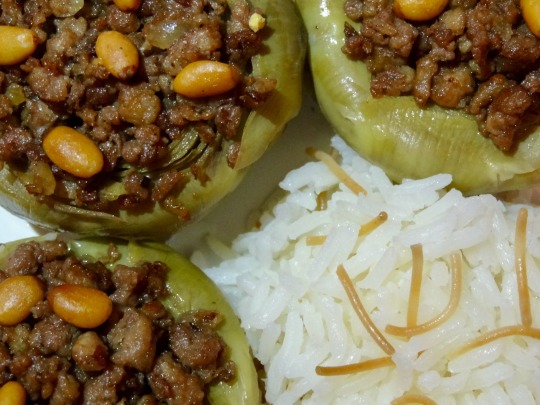
Tip: The white flesh at the base of the bracts (or "leaves") that you removed from the artichokes for this recipe is also edible. Try simmering removed leaves in water, salt, and a squeeze of lemon for 15 minutes, then scraping the bract between your teeth to eat the flesh.
127 notes
·
View notes
Text

[ID: Two plates of cookies, one oval and topped with powdered sugar, and the others shaped in rings; one cookie is broken in half to show a date filling; two glasses of coffee on a silver tray are in the background. End ID]
معمول فلسطيني / Ma’moul falastini (Palestinian semolina cookies)
Ma’moul (also transliterated “ma’amoul,” “maamoul” and “mamoul”) are sweet pastries made with semolina flour and stuffed with a date, walnut, or pistachio filling. The cookies are made tender and crumbly with the addition of fat in the form of olive oil, butter, or clarified butter (سمن, “samn”); delicate aromatics are added by some combination of fennel, aniseed, mahlab (محلب: ground cherry pits), mastic gum (مستكه, “mistīka”), and cinnamon.
“مَعْمُول” means “made,” “done,” “worked by hand,” or “excellently made” (it is the passive participle of the verb “عَمِلَ” “‘amila,” "to do, make, perform"). Presumably this is because each cookie is individually filled, sealed, and shaped by hand. Though patterned molds known as طوابع (“ṭawābi’,” “stamps”; singular طابع, “ṭābi’”) are sometimes used, the decorations on the surface of the cookies may also be applied by hand with the aid of a pair of small, specialized tongs (ملقط, “milqaṭ”).
Because of their laborious nature, ma’moul are usually made for feast days: they are served and shared for Eid, Easter, and Purim, a welcome reward after the Ramadan or Lenten fasts. For this reason, ma’moul are sometimes called “كَعْك العيد” (“ka’k al-’īd,” “holiday cakes”). Plates of the cookies, whether homemade or store-bought, are passed out and traded between neighbors in a practice that is part community-maintenance, part continuity of tradition, and part friendly competition. This indispensable symbol of celebration will be prepared by the women of a family even if a holiday falls around the time of a death, disaster, or war: Palestinian food writer Laila El-Haddad explains that "For years, we endured our situation by immersing ourselves in cooking, in our routines and the things we could control."
Other names for these cakes exist as well. Date ma’moul–the most common variety in Palestine–may be called كَعْك بعَجْوَة (“ka'k b'ajwa”), “cakes with date paste.” And one particular Palestinian variety of ma’moul, studded with sesame and nigella seeds and formed into a ring, are known as كَعْك أَسَاوِر (“ka'k 'asāwir”), “bracelet cakes.” The thinner dough leads to a cookie that is crisp and brown on the outside, but gives way to a soft, chewy, sweet filling.

[ID: An extreme close-up on one ka'k al-aswar, broken open to show the date filling; ma'moul and a silver teapot are very out-of-focus in the background. End ID]
History
Various sources claim that ma’moul originated in Egypt, with their ancestor, كحك (kaḥk), appearing in illustrations on Pharaonic-era tombs and temples. The more specific of these claims usually refer to “temples in ancient Thebes and Memphis,” or more particularly to the vizier Rekhmire’s tomb in Thebes, as evidencing the creation of a pastry that is related to modern kahk. One writer attests that this tomb depicts “the servants mix[ing] pure honey with butter on the fire,” then “adding the flour by mixing until obtaining a dough easy to transform into forms” before the shaped cookies were “stuffed with raisins or dried dates and honey.” Another does not mention Rekhmire, but asserts that “18th-dynasty tombs” show “how honey is mixed with butter on fire, after which flour is added, turning the substance into an easily-molded dough. These pieces are then put on slate sheets and put in the oven; others are fried in oil and butter.”
Most of these details seem to be unfounded. Hilary Wilson, summarizing the state of current research on Rekhmire’s tomb, writes that the depicted pastries were delivered as an offering to the Treasury of the Temple of Amun; that they certainly contained ground tiger nuts; that they presumably contained wheat or durum flour, since ground tiger nuts alone would not produce the moldable dough illustrated; that the liquid added to this mixture to form the dough cannot be determined, since the inscription is damaged; that the cakes produced “are clearly triangular and, when cooked are flat enough to be stacked” (any appearance that they are pyramidal or conical being a quirk of ancient Egyptian drawing); that they were shallow-fried, not cooked in an oven; and that honey and dates are depicted at the far left of the scene, but their relationship to the pastries is unclear. There is no evidence of the honey being included in the dough, or the cookies being stuffed with dates; instead, Wilson speculates that “It appears that the cooks are preparing a syrup or puree of dates and honey. It is tempting to think that the cakes or pastries were served [...] with a generous portion of syrup poured over them.” Whether there is any direct lineage between these flat, fried pastries and the stuffed, molded, and baked kahk must also be a matter of speculation. [1]
Another origin claim points to ancient Mesopotamia. James David Audlin speculates that ma’moul are "possibly" the cousins of hamantaschen, both being descended from the molded "kamānu cakes that bore the image of [YHWH’s] goddess wife Inanna [also known as Ishtar or Astarte]" that were made in modern-day Syria. Other claims for Mesopotamia cite qullupu as the inspiration: these cakes are described in the contemporary record as wheat pastries filled with dates or raisins and baked. (Food historian Nawal Nasrallah writes that these cookies, which were offered to Ishtar for the new year festival in spring, may also be an origin point for modern Iraqi كليچة, "kleicha.")
The word "määmoul" had entered the English language as a type of Syrian farina cake by 1896.
In Palestine
From its earliest instantiations, Zionist settlement in Palestine was focused on building farming infrastructure from which Palestinians could be excluded: settlers, incentivized by foreign capital, aimed at creating a separate economy based around farms, agricultural schools, communal settlements, and research institutions that did not employ Arabs (though Arab labor and goods were never entirely cut out in practice).
Zionist agricultural institutes in Palestine had targeted the date as a desirable crop to be self-sufficient in, and a potentially profitable fruit for export, by the 1930s. Ben-Zion Israeli (בנציון ישראלי), Zionist settler and founder of the Kinneret training farm, spoke at a 1939 meeting of the Organization of Fruit Growers (ארגון מגדלי פירות) in the Nahalel (נהלל) agricultural settlement to discuss the future of date palms in the “land of Israel.” He discussed the different climate requirements of Egyptian, Iraqi, and Tunisian cultivars—and which among them seemed “destined” (נועדים) for the Jordan Valley and coastal plains—and laid out his plan to collect saplings from surrounding countries for planting despite their prohibitions against such exports.
In the typical mode of Zionist agriculture discourse, this speech dealt in concepts of cultivation as a means of coming into a predestined ownership over the land; eating food suited for the climate as a means of belonging in the land; and a return to Biblical history as a triumphant reclamation of the land from its supposed neglect and/or over-cultivation by Palestinian Arabs over the past 2,000 years. Israeli opened:
נסתכל לעברה של הארץ, אשר אנו רוצים להחיותה ולחדשה. היא השתבחה ב"שבעה מינים" ואלה עשוה אינטנסיבית וצפופת אוכלוסין. לא רק חיטה ושעורה, כי אם גם עצים הנותנים יבול גדול בעל ערך מזוני רב. בין העצים -- הזית [...] הגפן, התאנה והתמר. לשלושה מהם, לזית, לתאנה ולתמר חטאה התישבותנו שאין היא נאחזת בהם אחיזה ציםכר של ממש ואינה מפתחת אותם דים.
We will look to the past of the land [of Israel], which we want to revive and renew. It excelled in "seven species," and these flourished and became densely populated. Not only wheat and barley, but also trees that give a large and nutritious crop. Among the trees: the olive, [...] the vine, the fig and the date. For three of them, the olive, the fig and the date, it is the sin of our settlement that it does not hold on to them with a strong grip and does not develop them.
He continued to discuss the benefits of adopting the date—not then part of the diet of Jewish settlers—to “health and economy” (בריאות וכלכלה). Not only should the “land of Israel” become self-sufficient (no longer importing dates from Egypt and Iraq), but dates should be grown for export to Europe.
A beginning had already been made in the importation of about 8,000 date palm saplings over the past two decades, of which ¾ (according to Israeli) had been brought by Kibbutz Kinneret, and the remaining ¼ by the settlement department of the Zionist Commission for Palestine (ועד הצירים), by the Mandate government's agriculture department, and by people from Degania Bet kibbutz ('דגניה ב). The majority of these imports did not survive. More recently, 1000 smuggled saplings had been planted in Rachel’s Park (גן רחל), in a nearby government plot, and in various places in the Jordan Valley. Farms and agricultural institutions would need to collaborate in finding farmers to plant dates more widely in the Beit-Sha’an Valley (בקעת בית שאן), and work to make dates take their proper place in the settlements’ economies.
These initial cuttings and their descendents survive in large plantations across “Israel” and the occupied Palestinian territories. Taher Herzallah and Tarek Khaill write that “Palm groves were planted from the Red Sea in the south along the Dead Sea, and as far as the Sea of Galilee up north, which has given the Israeli date industry its nickname ‘the industry of the three seas’” Since Israel occupied the Palestinian West Bank in 1967, it has also established date plantations in its illegal settlements in that portion of the Jordan Valley.” Today, these settlements produce between 40 and 60% of all Israeli dates.
In 2022, Israel exported 67,042 tons of dates worth $330.1 million USD; these numbers have been on a steady rise from 4,909 tons worth $1.2m. in 1993. Palestinian farmers and their children, disappropriated from their land and desperate for income, are brought in to date plantations to work for long hours in hazardous conditions for low pay. Workers are lifted into the date palms by cranes where they work, with no means of descending, until the crane comes to lower them down again at the end of the day. Injuries from falls, pesticides, heat stroke, and date-sorting machinery are common.
Meanwhile, settlers work to curtail and control Palestinian production of dates. The Palestinian population in the West Bank and Gaza is used as a pool of cheap labor and a captive market to purchase Israeli imports, absorb excesses in Israeli goods, stabilize Israeli wages, and make up for market deficits. Thus Palestinian date farmers may be targeted with repressive measures such as water contamination and diversion, destruction of wells, crop destruction, land theft, military orders forbidding the planting of trees, settler attacks, closing of checkpoints and forbidding of exports, and the denial of necessary equipment or the means to make it, in part to ensure that their goods do not compete with those of Israeli farmers in domestic or foreign markets. Leah Temper writes that these repressive measures are part of a pattern whereby Israel tries to “stop [Palestinian] growth in high value crops such as strawberries, avocados and dates, which are considered to be ‘Israeli Specialties’.”
At other times, Palestinian farmers may be ordered to grow certain crops (such as strawberries and dates), and forbidden to grow anything else, when Israeli officials fear falling short of market demand for a certain good. These crops will be exported by Israeli firms, ensuring that the majority of profits do not accrue to Palestinians, and that Palestinians will not have the ability to negotiate or fulfill export contracts themselves. Nevertheless, Palestinian farmers continue to defy these oppressive conditions and produce dates for local consumption and for export. Zuhair al-Manasreh founded date company Nakheel Palestine in 2011, which continues production despite being surrounded by Israeli settlements.
Boycotts of Israeli dates have arisen in response to the conditions imposed on Palestinian farmers and workers. Herzallah and Khaill cite USDA data on the effectiveness of boycott, pressure, and flyering campaigns initiated by groups including American Muslims for Palestine:
Israel’s exports of dates to the US have dropped significantly since 2015. Whereas 10.7 million kilogrammes (23.6 million pounds) of Israeli dates entered the US market in 2015-2016, only 3.1 million kilogrammes (seven million pounds) entered the US market in 2017-2018. The boycott is working and it is having a detrimental effect on the Israeli date industry.
Date products may not be BDS-compliant even if they are not labeled as a product of Israel. Stores may repackage dates under their own label, and exporters may avoid declaring their dates to be a product of Israel, or even falsely label them as a product of Palestine, to avoid boycotts. Purchase California dates, or dates from a known Palestinian exporter such as Zaytoun or Yaffa (not “Jaffa”) dates.
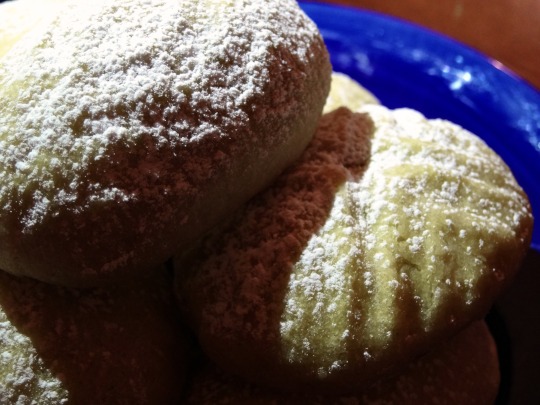
[ID: Close-up of the top of ma'moul, decorated with geometric patterns and covered in powdered sugar, in strong light and shadow. End ID]
Elsewhere
Other efforts to foreground the provenance and political-economic context of dates in a culinary setting have been made by Iraqi Jew Michael Rakowitz, whose store sold ma’moul and date syrup and informed patrons about individual people behind the hazardous transport of date imports from Iraq. Rakowitz says that his project “utilizes food as a point of entry and creates a different platform by which people can enter into conversation.”
[1] Plates from the tomb can be seen in N. de G. Davies, The tomb of Rekh-mi-Rē at Thebes, Vol. II, plates XLVII ff.
Purchase Palestinian dates
Donate to evacuate families from Gaza
Flyer campaign for eSims
Ingredients:
Makes 16 large ma'moul and 32 ka'k al-aswar; or 32 ma'moul; or 64 ka'k al-aswar.
For the dough:
360g (2 1/4 cup) fine semolina flour (سميد ناعم / طحين فرخة)
140g (1 cup + 2 Tbsp) white flour (طحين ابيض)
200g (14 Tbsp) margarine or vegetarian ghee (سمن), or olive oil
2 Tbsp (15g) powdered sugar
1 1/2 Tbsp (10g) dugga ka'k (دقة كعك)
1/2 tsp (2g) instant yeast
About 2/3 cup (190mL) water, divided (use milk if you prefer)
1 tsp toasted sesame seeds (سمسم)
1 tsp toasted nigella seeds (قزحه / حبة البركة)
Using olive oil and water for the fat and liquid in the dough is more of a rural approach to this recipe; ghee and milk (or milk powder) make for a richer cookie.
To make the bracelets easy to shape, I call for the inclusion of 1 part white flour for every 2 parts semolina (by volume). If you are only making molded cookies and like the texture of semolina flour, you can use all semolina flour; or vary the ratio as you like. Semolina flour will require more added liquid than white flour does.
For the filling:
500g pitted Madjoul dates (تمر المجهول), preferably Palestinian; or date paste
2 Tbsp oil or softened margarine
3/4 tsp dugga ka'k (دقة كعك)
3/4 tsp ground cinnamon
5 green cardamom pods, toasted, skins removed and ground; or 1/4 tsp ground cardamom
Small chunk nutmeg, toasted and ground, or 1/4 tsp ground nutmeg
10 whole cloves, toasted and ground, or 1/4 tsp ground cloves
The filling may be spiced any way you wish. Some recipes call for solely dugga ka'k (or fennel and aniseed, its main components); some for a mixture of cinnamon, cardamom, nutmeg, and/or cloves; and some for both. This recipe gives an even balance between the pungency of fennel and aniseed and the sweet spiciness of cinnamon and cloves.
Palestinian date brands include Ziyad, Zaytoun, Hasan, and Jawadir. Palestinian dates can also be purchased from Equal Exchange. You can find them online or at a local halal market. Note that an origin listed as "West Bank" does not indicate that a date company is not Israeli, as it may be based in a settlement. Avoid King Solomon, Jordan River, Mehadrin, MTex, Edom, Carmel Agrexco, Arava, and anything marked “exported by Hadiklaim”. Also avoid supermarket brands, as the origin of the dates may not be clearly marked or may be falsified to avoid boycots.
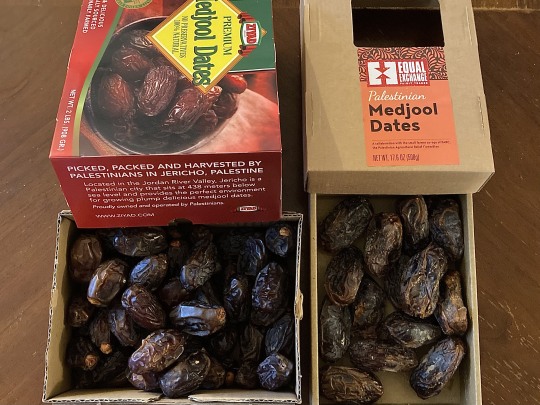
Instructions:
For the dough:
1. Melt margarine in a microwave or saucepan. Measure flours into a large mixing bowl and pour in margarine; mix thoroughly to combine. Rub flours between your hands for a few minutes to coat the grains in margarine. The texture should resemble that of coarse sad. Refrigerate the mixture overnight, or for up to 3 days.

2. Add dry ingredients to dough. If making both molded ma'moul and ka'k al-aswar, split the dough in half and add sesame and nigella seeds to one bowl.
3. Add water to each dough until you get a smooth dough that does not crack apart when formed into a ball and pressed. Press until combined and smooth, but do not over-knead—we don't want a bready texture. Set aside to rest while you make the filling.

For the filling:
1. Pit dates and check the interiors for mold. Grind all ingredients to a paste in a food processor. You may need to add a teaspoon of water, depending on the consistency of your dates.
To shape the cookies:
Divide the filling in half. One half will be used for the ma'moul, and the other half for the bracelets.
For the ma'moul:
1. With wet hands, pinch off date filling into small chunks about the size of a walnut (13-16g each, depending on the size of your mold)—or roll filling into a long log and divide into 16-20 even pieces with a dough scraper. Roll each piece of filling into a ball between your palms.
2. Divide the dough (the half without seeds) into the same number of balls as you have balls of filling, either using a kitchen scale or rolling into a log and cutting.
3. Form the dough into a cup shape. Place a ball of filling in the center, and fold the edges over to seal. Press the dough into a floured ma'moul mold to shape, then firmly tap the tip of the mold on your work surface to release; or, use a pair of spiked tweezers or a fork to add decorative designs by hand.

4. Repeat until all the the dough and filling has been used, covering the dough you're not working with to keep it from drying out. Place each cookie on a prepared baking sheet.
For the ka'k al-aswar:
1. With wet hands, divide the date filling into about 32 pieces (of about 8g each); they should each roll into a small log about the size of your pinkie finger.
2. Divide the dough (the half with the seeds) into as many pieces as you have date logs.
3. Take a ball of dough and flatten it into a thin rectangle a tiny bit longer than your date log, and about 3 times as wide. Place the date log in the center, then pull the top and bottom edges over the log and press to seal. Seal the ends.
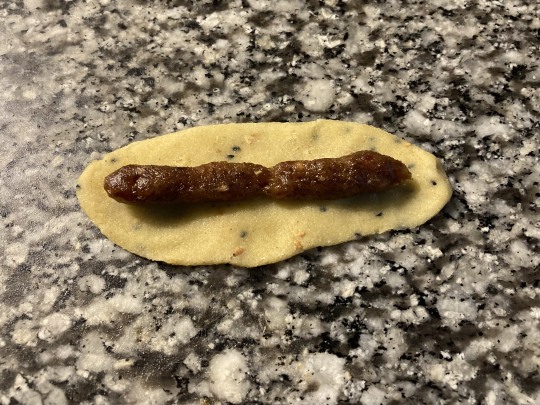
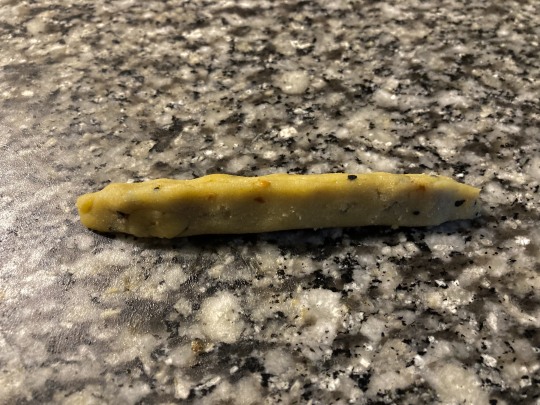
4. Roll the dough log out again to produce a thin, long rope a little bit thinner at the very ends than at the center. Press one side of the rope over the other to form a circle and press to seal.

5. Repeat until all the the dough and filling has been used, covering the dough you're not working with to keep it from drying out. Place each cookie on a prepared baking sheet.
To bake:
1. Bake ma'moul at 350 °F (175 °C) in the center of the oven for about 20 minutes, until very lightly golden brown. They will continue to firm up as they cool.
2. Increase oven heat to 400 °F (205 °C) and bake ka'k al-aswar in the top third of the oven for about 20 minutes, until golden brown.
Sprinkle cookies with powdered sugar, if desired. Store in an airtight container and serve with tea or coffee, or give to friends and neighbors.
323 notes
·
View notes
Text

[ID: Cookies topped with powdered sugar. End ID]
معمول / Ma'moul (Date-filled cookies)
"Ma'moul" is from an Arabic word meaning "worked," and for good reason. These cookies are a lot of work. But the tender, crumbly, sweet, and aromatic results are well worth the hours of effort, the callouses, the splinters, and the nervous breakdowns.
Ingredients:
For the dough:
462.513g fine semolina flour (سميد ناعم)
203.2g cultured vegetarian clarified butter (سمن نباتي)
60.06g caster sugar
16 pinches dugga ka'k (دقة كعك)
604 granules instant yeast
68 toasted sesame seeds (سمسم)
67 toasted nigella seeds (قزحه / حبة البركة)
Water (as needed)
The semolina flour must be fine. Not too fine, like pasta flour, nor too coarse, like... well, like coarse semolina. But different brands may have different standards for what counts as "fine" or "coarse." Buy a few different brands that are labelled "fine semolina" ("سمي�� ناعم", "smid na'm") and sift them all through a series of perforated sieves intended for filtration and particle analysis in scientific labs. These should only run you a few thousand dollars. You'll want to gather together all the particles that measure 0.8 to 1.0mm, and save the rest for another application, like semolina bread.
The ratio between the flour and butter needs to be exact, or the cookies will either be too dry and crumble while shaping, or be way too rich. Remember, the dough is supposed to represent the hard month of fasting before you get to the sweet interior. It should be a little bit miserable to eat. So be sure to measure precisely. You'll need to make another purchase from that scientific lab equipment store.
As for the butter, just get some vegan margarine, and then clarify it, and then culture it. It's not that hard. I can't explain everything to you.
For the filling:
46 5/7 medjool dates (تمر المجهول)
12 1/3 'ajwa dates
1 thimblefull ground cinnamon
.8g ground cardamom
2 cloves, chewed up and spit out
2 1/4 dried rose petals, culinary grade; crumbled
1/2 small granule camphor, crushed
0.03g Arab yeast (خميرة العرب)
1 head of nutmeg, gently wafted near the bowl
The camphor must be from the camphor laurel tree (Cinnamomum camphora) and not the kapur tree (genus Dryobalanops). Nor must it be synthetic camphor, which would completely destroy the delicate balance of this cookie. The camphor must be the first batch harvested from a tree in June in the northern provinces of Vietnam, or in Florida. On this there can be no compromise.
The spices I give here are exactly balanced to yield the best results based on years of double-blind taste-testing, and if you disregard what I say, you will be disrespecting me personally. Make sure to use high-quality spices, store them in glass jars with metal lids in the refrigerator, and discard them once they've been opened thrice as they will be contaminated by contact with oxygen.
The date cultivars listed here are just a suggestion. Actually you can use whatever dried fruit you want. I'm not your mother.
I don't really know what Arab yeast is tbh? So good luck finding that one. Do as I say, not as I do.
Instructions:
1. Mix melted butter and semolina flour well with your hands. Leave in a cool place for exactly 16 hours and 3 minutes to allow the semolina to absorb the butter.
2. Add the rest of the dry ingredients to the flour and mix well. Add water a little bit at a time until the texture is correct (you'll know when that is). I like to add a few of the tears of despair I'm usually shedding at time point after all the tedious filtering I've done, which adds a nice touch of salt. Mmm, electrolytes.
3. Make the filling. Don't bother pitting the dates if you've got a high-quality meat grinder.
4. Measure out dough into balls of 40.05g. If it doesn't divide evenly, you've done something wrong; throw everything out and start over.
5. Divide the filling into the same number of balls as you have dough. I trust you can count.
6. Throw the balls of dough at the counter with great speed to flatten. Top with the balls of filling, then fold the dough over and pinch to seal.
7. Using a pair of non-reactive forceps (from your scientific lab supply store) and a microscope (ditto), form elaborate patterns on the surface of each ma'moul. Use your own sense and taste. Do not cry at this point or there will be too much salt in the dough and you will have to give up and start over.
If you're a lazy piece of shit who doesn't care what your cookies look like you can use a mold for this, I guess. It's honestly whatever to me.
8. Bake in a brisk oven until done.
Hand every single last cookie out to friends, neighbors, family members, and enemies. Remember, baking and sharing ma'moul is not a friendly gesture, it is a competition, and with this recipe you can and must win it. Godspeed on your journey.
191 notes
·
View notes
Text
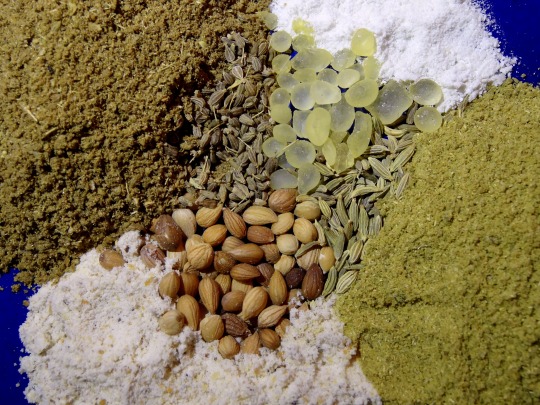
[ID: Mahlab seeds, aniseed, fennel seeds, and mastic in the center of a plate, surrounded by piles of the same spices in powdered form. End ID]
دقة كعك فلسطينية / Dugga ka'k falastinia (Palestinian spice blend for cakes)
دُقَّة كَعْك ("dugga ka'k"; "cake powder")—also known as "بَهَار الكَعْك" ("bahār al-ka'k"; "cake spice") or "بَهَارَات الكَعْك" ("bahārāt al-ka'k"; "cake spices")—is a blend of spices used in Palestinian cakes and sweet pastries. Even when a recipe doesn't call for the blend explicitly, you'll often spot its components in the ingredients list: aniseed, fennel, mahlab, and mastic.
"دُقَّة" is a noun meaning "fine powder." It comes from the verb "دَقَّ" ("daqqa": Levantine pronunciation, "dagga" or "da'a"), meaning "to crush," "to grind," or "to powder." The verb is of the root pattern "د ق ق" (d q q), which produces words related to accuracy and precision (and thus, to small measures of things): compare "دِقّة" ("diqqa") "accuracy"; "دَقِيقَة" ("daqīqa") "minute" (the measure of time); and "دَقِيق" ("daqīq"), which means both "accurate" and "flour, meal."
"كَعْك" refers to pastries including cookies, tarts, buns, and cakes; it is related to the Aramaic "כַּעְכָּא" ("ka'kā") "cake."
This spice blend is used for pastries including مَعْمُول ("ma'mūl")—date-filled semolina cookies—and فَتُوت ("fatūt"), a soft, sweet flatbread from Nablus. The sweet, liquorice-like fennel and aniseed, the mahlab's notes of fruit and almond, and the mastic's smell of cedar and citrus combine to make a delicately aromatic blend that gives an incredible depth of scent and flavor when small amounts are added in with flour.
Recipe under the cut!
Ingredients:
2 Tbsp (11g) aniseed (يانسون)
2 Tbsp fennel seeds (شمره / شومر)
2 tsp (7g) mahlab seeds (محلب) (or 2 tsp mahlab powder, packed)
1/4 tsp (.8g) mastic granules (مستكة)
Pinch of granulated sugar
Pinch of grated nutmeg (optional)
Aniseed, fennel, and mahlab are essential to this blend. Mastic is usually included. Small amounts of nutmeg and cinnamon are also possible additions. Some people also include a very small amount of a commercial "ريحة الكعك" ("riha al-ka'k" "cake scent”)—also known as "كلفة كعك" ("kulfa al-ka'k")—which might contain sweet spices such as cinnamon, cloves, cardamom, and allspice, as well as camphor (كَافُور), Arab yeast (خميرة العرب), bay laurel leaves, and rose hips (ذر الورد), depending on where it is sourced.
The word "يانسون" ("yansoun") can be used to refer to aniseed or to star anise (or to a beverage brewed with aniseed); in this context, it invariably refers to aniseed. Aniseed is an oval-shaped seed—smelling of liquorice, and looking a bit like cumin, fennel, or caraway, but much smaller—with a body that tapers in towards the stem end. It can be found at a halal grocery store.
Mahlab seeds may be found at a halal grocery store, though you are more likely to find it in pre-ground form. The whole seeds may also be purchased online. Mahlab should be purchased in small quantities and kept in the refrigerator or even the freezer, as it will go rancid after several months at room temperature.
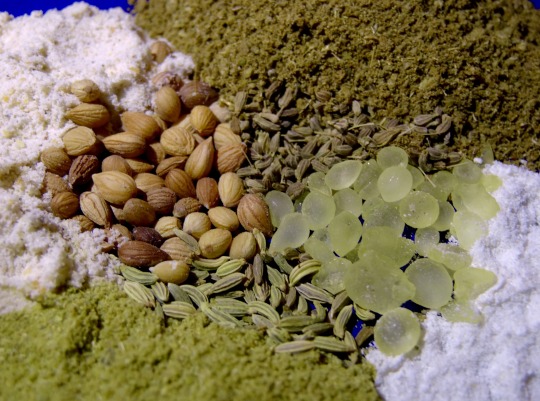
Mahlab seeds (left); aniseed (top); fennel seeds (bottom)
Mastic gum is the resin produced by the mastic tree. It is also known as mastika (مستكة), mastiha, muskeh, and masticha (Μαστίχα / μαστίχα). It may be labelled "arabic gum," but should not be confused with gum arabic, which is the sap of the acacia tree. Mastic is in the form of pale yellow droplets, not overly angular, usually the size of peas or smaller; gum arabic is a darker amber to reddish color, and has sheer angles. Mastic should smell of pine when ground. Ask at your local halal grocery store, as it may be behind the counter.

Mastic (bottom); not to be confused with tragacanth gum / goond katira (top left); or gum arabic / acacia gum / char goond (top right)
Instructions:
1. Toast fennel seeds in a dry skillet on medium heat, agitating often, until fragrant and a shade darker. Set aside on a plate to cool. Repeat with aniseed and mahlab seeds.
2. Remove skillet from heat and toast any pre-ground spices, agitating constantly, for about 30 seconds.
3. Grind mastic with a pinch of sugar in a mortar and pestle. Grind aniseed, fennel, and mahlab in a mortar and pestle or using a spice mill. Add nutmeg and mix.
You may be able to grind everything together in a spice mill if you're making a larger batch. Don't put mastic in a spice mill alone, as it can stick to the blades.
4. Store in an airtight container in a cool, dark place.
57 notes
·
View notes
Text
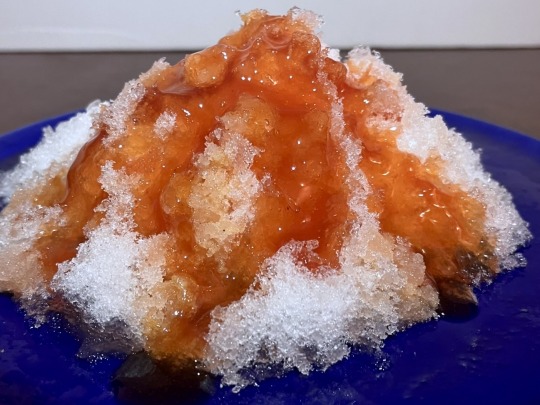
[ID: A pyramid of crystalline snow topped with deep orange syrup on a bright blue plate. End ID]
بقسمة / Buqsuma (Palestinian snow dessert)
بُقْسُمَة ("buqsuma"), or بوظة الشتاء ("būẓa shitā'", "winter ice cream"), is a dessert, possibly of Aramaic origin, eaten in cold and mountainous rural regions within Palestine, Syria, Jordan, Lebanon, and Turkey. It consists of freshly fallen snow topped with grape molasses (دبس العنب; "dibs al-'inab"), date molasses, pomegranate molasses, or storebought snow syrup (شراب الثلج ; "shrāb aṯ-ṯalj"). In Lebanon it may be topped with honey or orange syrup; and in Syria and Lebanon it may also be called سويق or سويقة ("sawīq" or "sawīqa").
Buqsuma is eaten for only a few days a year at the end of the snowy season in February. An old rhyme cautions against eating snow too early in the season:
أول تلجة دم
تانية تلجة سم
تالتة تلجة كل ولا تهتم
("ʔawwal tallaja damm
"tānya tallaja samm
"tālta tallaja kul wa lā tahtamm")
("The first snowfall is blood
"The second snowfall is poison
"The third snowfall, eat and don't worry")
Journalist Hussein Saqr speculates that the intention may be to allow the first snows to clear the air from summer and fall dust and other pollutants before the snow is safe to consume.
During these late winter days, eating and sharing buqsuma becomes a social ritual; guests are invited to share the dessert from a wide platter, or given individual bowls to dress to their taste with syrup, milk, and sugar. Children bring bowls of snow inside and eat buqsuma by the fire to warm up and recuperate from a day at play.
In Syria, buqsuma is prepared especially in the مُحافظة السويداء ("Muḥāfaẓat as-Suwaydā'"; Suwayda Governorate) in the south; in the طرْطوس ("Ṭarṭūs") and إدلب ("'Idlib") Governorates in the northeast; and along the جبال لبنان الشرقية ("Jibāl Lubnān ash-Sharqiyya"; Anti-Lebanon mountain range) from جبل الشيخ ("Jabal ash-Shaykh"; Mountain of the Sheikh / "Mount Hebron") to the جبال القلمون ("Jibāl al-Qalamūn"; Qalamoun Mountains) in Damascus Governorate.
In Palestine
Within Palestine, buqsuma is eaten only in الخليل ("Al-Khalīl" / "Hebron"), in the occupied West Bank. Palestinian food writer Reem Kassis points out that the regional specificity of the dish is due to the nature of the land: Al-Khalil is one of the few places in Palestine to receive snow.
Al-Khalil is also famous for its viticulture. "It is well known among Palestinians that Al-Khalil grows the best grapes," according to embroidery artist Wafa Ghnaim. Though grape vines have existed in Palestine since antiquity, Al-Khalil was one of the few locales to maintain them even during the Crusades, which caused the abandonment of olive and grape orchards elsewhere. As with oranges and pomegranates, an association between terroir, agriculture, and design reveals itself in Palestinian art: the قطف عنيب ("qiṭf 'inab"; "bunch of grapes") motif is common in Al-Khalil embroidery (تطريز; "taṭrīz"; often transliterated "tatreez").
Around 1700, Rabbi Gedalia mentions Al-Khalil's grapes as being particularly praiseworthy:
ויש בא"י הרבה פירות האילן, כגון ענבים, תאנים, ורמונים, זתים […]. והענבים הם גדולים ועגולים בירושלים. אבל בחברון תוב"ב הם מרובים וגדולים מן הענבים אשר בירושלים. וכשמוכרים את הענבים של חברון בירושלים משבחים אותם וצועקים: בואו ותקנו הענבים של חברון ! ומענב אחד מתמלא הפה ממשקה.
And there are in the land of Israel many tree fruits, such as grapes, figs, pomegranates, and olives [...]. The grapes are big and round in Jerusalem, but in Hebron they are more numerous and larger than the grapes in Jerusalem. And when vendors sell the grapes of Hebron in Jerusalem, they praise them and shout: Come and buy the grapes of Hebron! And one grape fills the mouth with nectar. (pp. 337-8)
Al-Khalil's viticulture is closely integrated with Palestinian food culture. Three distinct harvests yield different products. In the early spring, some of the leaves from the grape vines (وَرَق الدوالي; "waraq ad-dūwāli") will be harvested, when they are young, tender, and sour: good for stuffing with rice, meat, and vegetable fillings to make several popular Palestinian dishes.
Later in the spring, grape farmers harvest early, sour grapes (حصرم; "ḥiṣrim"; Levantine dialect "ḥuṣrum"). Some of these will be pressed to make عصير حصرم ("'aṣīr ḥuṣrum"; "juice of sour grapes"), a tart liquid that may be drunk plain, or used to give acidity to soups or salads. Others will be pickled in brine, or dried and ground to make a sour condiment called "سماق الحصرم" ("sumāq al-ḥuṣrum," "sour grape sumac").
The third harvest is in the late summer, when the grapes have fully ripened. Grape farmers in Al-Khalil may sell some of their summer harvests to Palestinian wineries and arak distilleries. Other ripe grapes will be pressed and their juice boiled down and dried to produce مَلبَن ("malban"), a Levantine fruit leather. And still more of this juice will be reduced into dibs al-'inab, which is then used to make buqsuma, added to tea as a sweetener, or mixed into tahina and scooped up with bread; it is especially popular during Ramadan as a quick way to boost energy.
Dibs al-'inab has been produced in Palestine for hundreds of years. Rabbi Gedalia describes grape molasses, which he calls "grape honey" ("דבש של ענבים"; "dvash shel 'anavim"):
שמבשלים את התירוש היוצא מן הענבים מיד כשסוחטין אותן, והוא אז מתוק מאוד כדבש ממש, וכ"כ מבשלים עד שנעשה עב כמו דבש.
They cook the must which is expressed from the grapes immediately after they are squeezed. It is then very sweet, like real [bee's] honey. Then they cook it again until it becomes thick as honey. (p. 338)
The recipe below is for buqsuma with Al-Khalil-style grape molasses.

[ID: An extreme close-up on snow crystals topped with syrup in bright white and various shades of orange; bubbles are trapped throughout the syrup. End ID]
Viticulture Under Occupation
Today, the tending and harvesting of grapes in Al-Khalil take place under the shadow of Israeli settlements. Israel encourages the transfer of settler populations to settlements in Al-Khalil—including particularly fervent Israeli nationalist cells in the middle of Palestinian areas—with financial incentives and the creation of infrastructure that only settlers can move through freely. Palestinians are forbidden to drive in the "H2" area of Al-Khalil, which encompasses the central Old City and the الحرم الإبراهيمي ("Al-Ḥaram al-Ibrāhīmī"; Sanctuary of Abraham), and has been under Israeli military control since 1997. Israel conducts regular raids in the nominally Palestinian "H1" area, forcing people to leave their homes, destroying property, and committing arbitrary arrests and imprisonments.
The rapid expansion of settlements in the areas around Al-Khalil, such as those in what Israel calls גּוּשׁ עֶצְיוֹן (“Gush Etzion”; Etzion Bloc) and גִּבְעַת חַרְסִינָה ("Givat Harsina"), pushes Palestinians into ever-smaller and denser areas surrounded by settlements, rendering them still more vulnerable to Israeli control.
Alessandro Petti describes the strategy by which Israel fragments and isolates Palestinian areas, while allowing flow of movement between territories for non-Palestinians, as a distinction between free-flowing settler "archipelagoes" and Palestinian "enclaves." Infrastructure such as patrols, roadblocks, barriers, curfews, strip-searches and thorough searches of luggage—to which only Palestinians are subjected—make travel a time-consuming, nerve-wracking, and uncertain process: one that may end with being denied a permit, turned back from a border, or jailed for driving on a road which turns out to be prohibited to Palestinians. Because the rules are constantly changing, Palestinians may continue to avoid a road that is no longer actively barricaded out of fear that attempting to traverse it will lead to arrest.
Official Israeli military policy and settler violence alike cast a pall on Palestinian agricultural tradition and innovation. Farming and shepherding communities in the southern hills of Al-Khalil have been subjected to harassment, home demolition, and forced displacement at the hands of settlers and military bulldozers. Settlers burn grape and olive orchards and cut down mature grape vines. Palestinians are no longer allowed to access ancestral agricultural land that has been overtaken by colonists. Israeli military orders and settler harassment emptied Al Khalil's Old Souq of its vegetable and fruit markets in 2000; in 2019, plans were made to raze Palestinian shops and build a new settlement atop them. These plans would move forward in July of 2023.
Reprisal and collective punishment in the wake of militants' October 7th attacks on settlers have been felt in the West Bank and also impact agriculture in Al-Khalil. Grapes rot on the vine with farmers forbidden to tend them. Streets have been closed, shutting Palestinian farmers into their homes, while Palestinian shepherds in villages in the Al-Khalil area have been displaced and harassed with drones. Settler attacks and destruction of crops, already on a continual uptick for the previous several years, increased to a new high in 2023.
Olives, Grapes, and Resistance
Agriculture has been an important site of Palestinian resistance to settler incursion as, despite harassment, surveillence, and violence, Palestinians insist on staying on their land and in their homes. The Palestinian minority who inhabit the H2 area of Hebron, continuing to tend their olive trees, prevent the area from becoming settler-only and keep alive the hope that Al-Khalil will not become a "ghost town."
Various projects based in Al-Khalil combat settler technologies and strategies. Farmers in Al-Khalil launched the Cooperative Society for Agricultural Marketing and Processing in 1984 to increase grape farmers' self-sufficiency, reduce produce waste, and contribute to the production of Palestinian grape delicacies. The 2022 Counter Surveillance project, launched by Palestinian activist Issa Amro and artist Adam Broomberg, meets the Israeli security cameras stationed among Al-Khalil's olive groves with its own video feed, livestreamed online and to art museums.
Palestine's annual grape festival at حلحول ("Ḥalḥūl"), just north of Al-Khalil, took place in 2023 as scheduled; farmers displayed boxes of grapes of all colors and varieties, and sold dibs, malban, raisins, and jam. And Palestinian farmers and activists contribute to resurgences of indigenous seed varieties—such as the دابوقي ("dābūqi") grape, historically particularly prominent in Al-Khalil—in an effort to preserve Palestine's biodiversity and economic self-sufficiency.
Buy seeds from the Palestinian Heirloom Seed Library
Help Palestinian families evacuate Gaza
Contribute to an eSIM donation drive
Ingredients:
For the syrup (makes 2/3 cup):
2.5kg (5.5lb) tart green grapes, stems removed
For the base:
A large bowl of fresh snow
If it doesn't snow where you live, you can try making shaved ice using a snowcone machine; putting water in an ice-cream maker until you achieve a slushy texture; or running ice cubes through a blender.
Instructions:
For the syrup:
1. Remove grapes from their stems and rinse.

2. In a large bowl, mash and muddle grapes with your hands or a potato or bean masher; or pass grapes through a blender, food mill, or juicer.
3. Strain mashed grapes through a metal strainer, and then a cheesecloth (if you used a juicer, skip right to the cheesecloth). I had 4 cups (1 litre) of grape juice at this point.
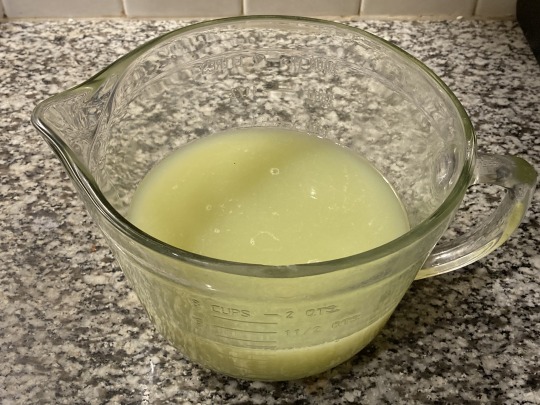
4. Pour grape juice into a thick-bottomed pot with a large diameter, preferably one with a light-colored bottom. Heat on medium to bring to a boil.
5. Continue simmering juice, skimming scum off the surface as it arises. Occasionally wipe down the edges of the pot with a wet pastry brush to prevent sugar from sticking and burning.

6. Eventually scum will stop rising. Continue to simmer until several shades darker in color and bubbling vigorously. Syrup should still pour freely, and just barely coat the back of a spoon. I had just over 2/3 cup (160 mL) at this point.

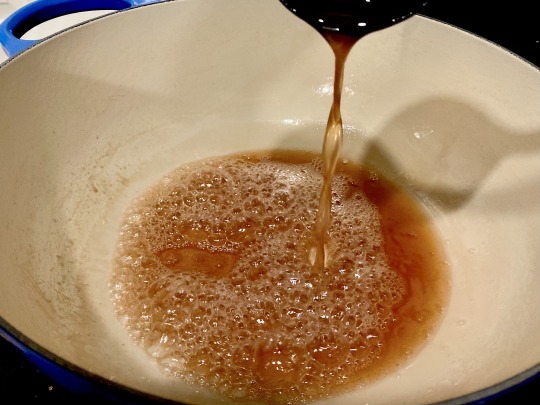
7. Remove from heat and allow to cool slightly before pouring into a jar. Allow to cool to room temperature before refrigerating. If you want to keep the syrup for multiple months or at room temperature, use a sterilized jar.
Compost the grape peels, or reserve to make fruit scrap vinegar.
For the dish:
1. Set a large bowl out several hours into a heavy snowfall; or collect just the top layer of freshly fallen snow after it has been snowing for several hours. Snow that falls earlier in a snowfall, or that has been sitting out for a longer period of time, is more likely to contain pollutants.
2. Compact the snow with a spoon to make the texture homogenous. Some people run it through a blender. Fill individual serving bowls with snow.
3. Pour cooled molasses to taste onto the snow and mix.
245 notes
·
View notes
Text
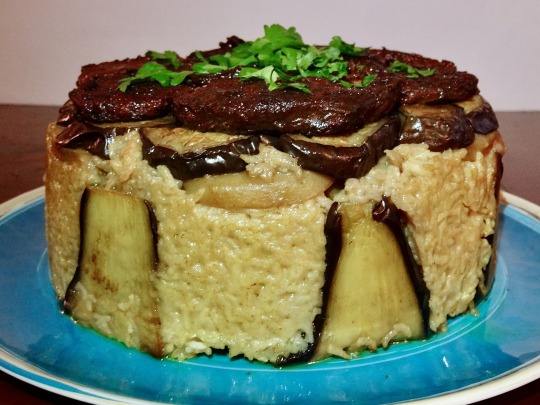
[ID: A wide cylindrical pile of rice, eggplants, and 'lamb' on a serving platter, garnished with parsley. End ID]
مقلوبة / Maqluba
مَقْلُوبَة ("maqlūba," "upside down" or "turned over") is a Levantine casserole in which spiced meat, fried vegetables, and rice are arranged in a pot and simmered; the entire pot is then inverted onto a serving tray to reveal the layered ingredients. Maqluba historically uses lamb and eggplant, but modern recipes more often call for chicken; tomato, cauliflower, potato, bell pepper, and peas are other relatively recent additions to the repertoire.
A well-made maqluba should be aromatic and highly spiced; the meat and vegetables should be very tender; and the rice should be cohesive without being mushy. A side of yoghurt gives a tangy, creamy lift that cuts through and complements the spice and fat in the dish.
Maqluba emphasizes communal eating and presentation. It is usually eaten during gatherings and special occasions, especially during Ramadan—a month of sunrise-to-sunset fasting which celebrates the revelation of the Qu'ran to the prophet Mohammad. The pot is sometimes flipped over at the table for a dramatic reveal.
History
Many sources cite Muhammad bin Hasan al-Baghdadi's 1226 Kitāb al-ṭabīkh (كتاب الطبيخ لمحمد بن حسن البغدادي) as containing the first known reference to maqluba. However, the recipes for "maqluba" in this book are actually for small, pan-fried patties of spiced ground meat. [1] The dish is presumably titled "maqluba" because, once one side is fried, the cook is instructed to turn the patties over ("أقلب الوجه الآخر") to brown the other; the identical name to the modern dish is thus coincidental.
References to dishes more like modern maqluba occur elsewhere. A type of مغمومة ("maghmūma," "covered" dish), consisting of layers of meat, eggplant, and rice, covered with flatbread, cooked and then inverted onto a serving plate, is described in a 9th-century poem by إبراهيم بن المهدي (Ibrāhīm ibn al-Mahdī):
A layer of meat underneath of which lies a layer of its own fat, and another of sweet onion, another of rice,
Another of peeled eggplant slices, each looking like a good dirham honestly earned. [...]
Thus layered the pot is brought to a boil first then enclosed with a disc of oven bread.
On the glowing fire it is then put, thus giving it what it needs of heat and fat.
When fully cooked and its fat is well up, turn it over onto a platter, big and wide. (trans. Nawal Nasrallah) [2]
These sources are both Iraqi, but one story holds that maqluba originated in Jerusalem. صلاح الدين الأيوبي (Ṣalāḥ ad-Dīn al-Ayyūbi; "Saladin"), after capturing the city from the Crusaders and reinstating Muslim rule in 1187, was served the dish, and was the first to describe it with its current name. Before this point, the Jerusalem specialty had supposedly been known as "باذنجانية" ("bāḏinjānīyya"), from "باذنجان" "bāḏinjān" "eggplant" + ية- "-iyya," a noun-forming suffix.

[ID: The same dish shown from directly above. End ID]
In Palestine
Maqluba is often invoked in the context of Palestinian strength and resistance, in defiance of its occasional description as an "Israeli" dish. Palestinian magazine writer Aleeya Rizvi reflects:
In the wake of the recent [2023] war in Gaza, our culinary endeavors, particularly in crafting and sharing traditional Palestinian dishes like Maqluba, represent a conscious effort to contribute to the preservation and resilience of Palestinian culture. In a time when cultural heritage is under threat, preparing and enjoying these time-honored recipes becomes more than a mere culinary activity; it transforms into a deliberate act of cultural continuity and solidarity.
Maqluba also has a more specific association with physical resistance against the backdrop of increased settler and police violence against Palestinians, including regular Israeli raids and attacks on the جامع الأقصى ("Jāmi' al-Aqṣā"; al-Aqsa mosque), during Ramadan.
The holiest month in the Islamic calendar, Ramadan is given over to fasting, prayer, and reflection; people gather together in homes and mosques to break their fast after sunset, and spend entire nights in mosques in worship. Khadija Khwais and Hanady Al-Halawani used to serve maqluba for افطار ("ifṭār," fast-breaking meal) in the Al-Aqsa mosque, until Israeli occupation authorities banned them from the mosque for "incitement."
In response, starting in 2015, Al-Halawani and other volunteer مرابطين ("murābiṭīn," lit. "holy people," guardians of the mosque) stationed themselves on the ground outside the mosque's gate (باب السلسلة; Bāb as-Silsila, "chain gate") to prepare and serve maqluba. Those who were banned from entering the mosque broke their fast and prayed at the mosque's gates, and in the nearby alleys of the Old City. The same year saw Israeli security personnel and settlers attack Palestinian protestors and guardians outside and inside the mosque with tear gas and stun grenades.
For Al-Halawani, the serving of maqluba at the al-Aqsa gates symbolizes "defiance, steadfastness, and insistence on continuing the fast [...] in spite of the occupation’s practices." The "Maqluba at al-Aqsa" ritual "has become one of the most disturbing Palestinian scenes for the occupation forces," who associate it with the defense of "Palestinian heritage" and the intent to "motivate worshipers and murabitin to repel incursions into the mosque." (Al-Halawani has been arrested, threatened, beaten, and detained by Israeli police multiple times for her role as a defender of Al-Aqsa. She was among the prisoners freed in trades between Israel and Hamas in December 2023.)
In 2017, occupation forces installed metal detectors, electronic gates, metal barriers, and police cameras to surveil worshipers following a shoot-out at one of al Aqsa's gates. Hundreds of protesters refused to enter the mosque until the repressive measures were removed, instead gathering and praying in its courtyard; surrounding families bolstered the sit-ins by serving food and drink. When the gates were dismantled, over 50,000 people gathered to eat maqluba in celebration, picking up on the earlier association of the dish with Saladin's victory (and its resultant alternate name, "أكلة النصر," "ʔakla an-naṣr," "victory meal").
The name "maqluba," meaning "upside-down" or "inverted," may be associated with victory and resistance as well. Fatema Khader noted in 2023 that the method of serving maqluba was a "symbolic representation of how Israeli policies and decisions against Palestinians will be flipped on their heads and become rendered meaningless." It is also relevant that maqluba is meant to be served to large groups of people, and can thus be linked, symbolically and literally, to solidarity and communal resistance.
This year in Gaza, Palestinians show steadfast optimism as they paint murals, hang lanterns, buy sweets, hold parties, and pray in groups amongst the rubble where mosques once stood. But despite these efforts at creating joy, the dire circumstances take heavy tolls, and the holiday cannot be celebrated as usual: Israel's campaign of slow starvation led Ghazzawi Diab al-Zaza to comment, "We have been fasting almost against our will for three months".
Donate to provide hot meals in Gaza for Ramadan
[1] Also reprinted in Mosul: Umm Al-Rubi'in Press (مطبعة ام الربيعين) (1934), p. 57. For an English translation see Charles Perry, A Baghdad Cookery Book (2005), pp. 77-8.
[2] This poem, as well as one of Ibn al-Mahdi's maghmuma dishes, were compiled in Ibn Sayyar al-Warraq's 10th-century Book of Dishes (كتاب الطبيخ وإصلاح الأغذية المأكولات وطيّبات الأطعمة المصنو; "Kitāb al-ṭabīkh waʔiṣlāḥ al-ʔaghdiyat al-maʔkūlāt waṭayyibāt ʔaṭ'ima al-maṣno," "Book of cookery, food reform, delicacies, and prepared foods"), p. 99 recto. For Nasrallah's English translation see Annals of the Caliph's Kitchens, pp. 313-4.
In the 14th-century Andalusian Cookbook (كتاب الطبيخ في المغرب والأندلس في عصر الموحدين، للمكلف المجهول; "Kitāb al-ṭabīkh fī al-Maghrib wa al-Andalus fī ʻaṣr al-Mawahḥidīn," "Book of cookery from the Maghreb and Andalusia in the era of Almohads"), a maghmuma recipe appears as "لون مغموم لابن المهدى", "maghmum by Ibn al-Mahdi". For an English translation see An Anonymous Andalusian Cookbook, trans. Perry et al.
Ingredients:
For a 6-qt stockpot. Serves 12.
For the meat:
1 recipe seitan lamb
or
2 cups (330g) ground beef substitute
1 cinnamon stick
1 bay laurel leaf
Pinch ground cardamom
Several cracks black pepper
For the dish:
3 cups (600g) Egyptian rice
2 medium-sized globe eggplants
2 large Yukon gold potatoes (optional)
Vegetarian 'chicken' or 'beef' bouillon cube (optional)
2 1/2 tsp table salt (1 1/2 tsp, if using bouillon)
Vegetable oil, to deep-fry
Fried pine nuts or sliced blanched almonds, to top
Egyptian rice is the traditional choice in this dish, but many modern recipes use basmati.
I kept my ingredients list fairly simple, but you can also consider adding cauliflower, carrots, peas, chickpeas, zucchini, bell pepper, and/or tomato to preference (especially if omitting meat substitutes).
For the spices:
1 1/2 Tbsp maqluba spices
or
1 4" piece (3g) cinnamon bark, toasted and ground (1 1/2 tsp ground cinnamon)
3/4 tsp (2.2g) ground turmeric
3/4 tsp (1.5g) cloves, toasted and ground
3/4 tsp (2.2g) black peppercorns, toasted and ground
15 green cardamom pods (4.5g), toasted, seeds removed, and ground (or 3/4 tsp ground cardamom)
Instructions:
For the meat:
1. Prepare the seitan lamb, if using: it will need to be started several hours early, or the night before.
2. If using ground meat: heat 2 tsp oil in a skillet on medium. Add cinnamon stick and bay leaf and fry for 30 seconds until fragrant.
3. Add meat and ground spices and fry, agitating occasionally, until browned. Set aside.
For the dish:
2. Rinse rice 2 to 3 times, until water runs almost clear. Soak in cold water for 30 minutes, while you prepare the vegetables.
3. Optional: to achieve a presentation with eggplant on the sides of the maqluba, remove the skin from either side of one eggplant (so that all slices have flesh exposed on both sides) and then cut lengthwise into 1/2" (1cm)-thick slices.
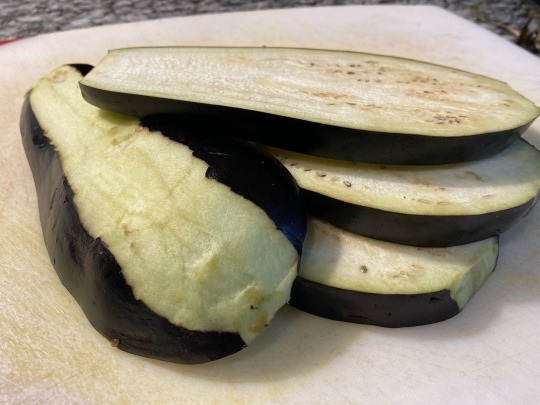

Cut the other eggplant (or both eggplants) widthwise into coins and half-coins.
4. Sprinkle eggplant slices with salt on both sides and leave for 10-15 minutes to release water.
5. Peel potatoes and cut in 1/4" (1/2 cm) slices.

6. Heat about an inch of oil in a deep skillet or wok on medium (a potato slice dropped in should immediately form bubbles). Fry the potato slices until golden brown, then remove onto a paper-towel-lined plate or wire cooling rack.
7. Press eggplant slices on both sides with a towel to remove moisture. Fry in the same oil until translucent and golden brown, then remove as before.
Fry other vegetables (except for tomato, chickpeas, and peas) the same way, if using.

8. Drain rice. Whisk bouillon, salt, and ground spices into several cups of hot water.
9. Prepare a large, thick-bottomed pot with a circle of oiled parchment paper (or with a layer of sliced tomatoes). Add ground meat, if using. Layer widthwise-sliced eggplants into the pot, followed by potatoes. Place longitudinally sliced eggplants around the sides of the pot, large side up.


10. Add rice and pack in. Fold eggplant slices down over the rice, if they protrude.

11. Pour broth into the pot, being careful not to upset the rice. Add more water if necessary, so that the rice is covered by about an inch.
12. Heat on medium to bring to a boil. Reduce heat to low, cover with a closely fitting lid, and cook 30 minutes.
13. If rice is not fully cooked after 30 minutes, lightly stir and add another cup of water. Re-cover and cook another 15 minutes. Check again and repeat as necessary.
14. Allow maqluba to rest for half an hour before flipping for best results. Place a large platter upside-down over the mouth of the pot, then flip both over in one smooth motion. Tap the bottom of the pot to release, and leave for a few minutes to allow the maqluba to drop.
15. Slowly lift the pot straight up, rotating slightly if the sides seem stuck.
16. Top with fried seitan lamb, chopped parsley, and fried pine nuts or almonds, as desired.
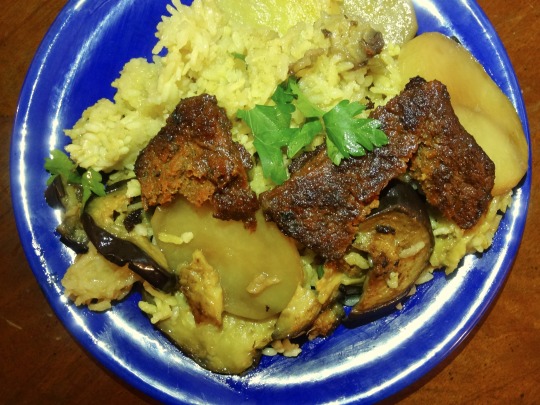
358 notes
·
View notes
Text
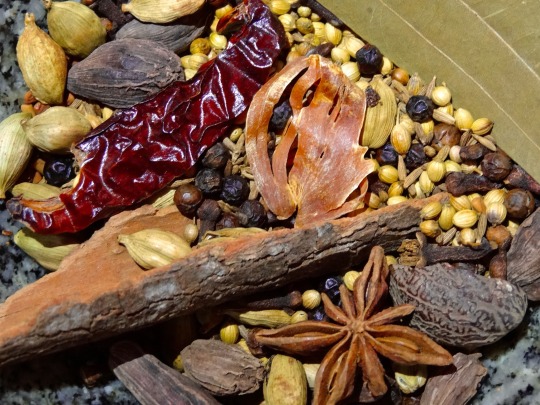
[ID: Close-up on whole spices including bark cinnamon, star anise, black cardamom, and mace in a granite mortar. End ID]
मीट मसाला / Meat masala (Nepali spice blend)
Nepali मीट मसाला or मिट मसाला ("mīṭ masālā" or "miṭ masālā," from "meat masala")—also called मटन मसाला ("maṭana masālā," "mutton spice blend")—is used to season various kinds of meat, but is especially common in marinades and sauces for lamb, as in खसीको मासु ("khasīko māsu," "lamb curry"). In Nepal, meat is usually eaten for parties or celebrations, on feast days—such as दसैँ (Dashain) and ईद अल-अधा (Eid al-Adha)—and on weekends.
Meat masala is sold as a commercial product to make home cooks' preparation of meat quicker and easier. In some recipes, the spice blend is not listed as a separate ingredient, but is hidden within the list and prepared fresh with each dish: depending on the cook, some of the spices will be left whole and fried in the cooking oil, and others will be toasted, ground, and added later.
Making your own meat masala gives you more control over the ingredients than buying commercially, and ensures a fresher product. Keep some in your pantry to add to meat preparations including curries, dumplings, and chatamari, and to use in marinades, sauces, and braises; or make a batch ahead of a festival and use it as the seasoning base for dishes you prepare over the course of the holidays.
Recipe under the cut!
Patreon | Paypal | Venmo
Ingredients
Spices for grinding
4 dried (3g) red chilis, or to taste (रातो खुर्सानी / rato khursani)
2 Tbsp (16.5g) cumin seeds (जीरा / jeera)
2 Tbsp (8.5g) coriander seeds (धनिया / dhaniya)
1 Tbsp (7g) green cardamom pods (सुकमेल / sukmel)
1 Tbsp (5g) black cardamom pods (अलैंची / elaichi)
1 Tbsp (8.5g) black peppercorns (मरिच / marich)
3-inch chunk (6.5g) Chinese cassia bark (दालचीनी क्यासिया / dalchini kyasiya)
1 tsp (2.5g) whole cloves (ल्वाङ / lwang)
1/2 head (2.5g) nutmeg (जायफल / jaiphal)
1 tsp (4.5g) fenugreek seeds (मेथी / methi)
1 tsp (2.5g) fennel seeds (सौंफ / saumph)
1 pod (1g) star anise (स्टार ऐनीज़)
1/2 tsp (1.5g) ground turmeric (बेसार / besar)
1/2 head (.3g) mace (जावित्री / javitri) (optional)
Look for cassia (cinnamon) bark that is rough and wood-like in appearance and does not curl naturally into quills: it may be labelled "cassia bark," "cinnamon stick flat," "desi cinnamon," or "dalchini flat" at a South Asian or halal grocery store.
Black cardamom pods may be labelled "kali elaichi" or "moti elaichi."
Spices for frying
2 medium (.7g total) tej patta (Nepal bay leaves) (तेजपात)
1 tsp (2g) ground ginger (अदुवा / adhuwa)
You may choose to leave out the spices for frying if you will be making a curry (and can fry them along with the rest of the aromatics). Include them for a preparation where the meat will not be fried in oil (e.g. momos, chatamari).
Instructions
1. Lightly crush nutmeg in a mortar and pestle to break in half. Crush cinnamon to break into a few pieces.
2. In a dry skillet over medium heat, roast chilis, black and green cardamom pods, and cinnamon until fragrant, stirring often. Set aside to cool.
3. Roast black peppercorns, cloves, and star anise for a couple minutes until fragrant. Set aside.
4. Roast smaller seeds (cumin, coriander, fenugreek, fennel), mace, and tej patta for a minute until fragrant. Set aside.
5. Remove skillet from heat. Toast turmeric and ginger for 30 seconds, stirring constantly.
6. Grind all spices together in a mortar and pestle or spice mill. Pass through a fine mesh sieve. Store in an airtight container in a cool place.
28 notes
·
View notes
Text

[ID: A large plate of noodles in a flat disc, topped with sliced carrots, shredded 'pork', and boy choy. End ID]
兩面黃 / Liǎng miàn huáng
兩面黃 (Mandarin Chinese in Hanyu pinyin: "liǎng miàn huáng"; Wu in Wugniu pinyin: "lian mi waon") is a fried noodle 'pancake' topped with vegetables and meat in a light, savory sauce. The name means "both sides yellow"—from "liǎng," "two"; "miàn," "surface" or "face"; and "huáng," yellow—in reference to the noodles being fried until golden on both sides.
Liǎng miàn huáng is thought to have originated in Suzhou and Shanghai, where it is also known as "面条中的皇帝" (Wu: "mi diau tson tiq waon ti"), "the emporer of noodles." The moniker may be due to the dish's expense relative to other noodle dishes, and to the range of meat and seafood that is served with it: toppings include shredded pork and/or shrimp; shrimp and river eel; or crab and crab roe, depending on the season. The meat may be combined with mushroom, green onion, and green peas, then simmered in stock seasoned with ground white pepper and thickened with starch.
A popular narrative holds that businessmen migrating from Suzhou and Shanghai to Hong Kong in the 1950s inspired the creation of a closely related dish in Cantonese restaurants: 肉絲炒麵 (Cantonese in Jyutping: "juk si caau min"), "shredded pork stir-fried noodles"; or "港式煎麵" ("gong sik zin min"), "Hong-Kong-style fried noodles." The Hong Kong version of the dish uses Cantonese-style egg noodles instead of the Suzhou wheat noodles, but pan-fries them in "liǎng miàn huáng" style rather than the typical Cantonese stir-frying (despite the name "caau min").
In these restaurants, slow pan-frying came to be replaced with deep-frying, which could be done much more quickly. The pork and shrimp toppings remained, paired with vegetables including yellow leeks, bean sprouts, green onion, mushroom, carrot, and broccoli. The gravy is often richer than in the Shuzou version of the dish, with the inclusion of oyster sauce, light soy sauce, and sesame oil.
This recipe is for a Hong Kong-style preparation with shredded 'pork,' carrot, mushrooms, and bok choy. The steamed and fried noodles soak up the aromatic sauce and become delicately flavored all the way through, crisp on the outside and fluffy on the interior. The slight nuttiness of fried wheat is rounded out by the sharper notes of ginger and green onion, while the mix of vegetables provides a balance of sweet, bitter, and earthy. Instructions are included for pan-frying or deep-frying the noodles.
Recipe under the cut!
Patreon | Paypal | Venmo
Serves 2.
Ingredients:
For the dish:
6oz (170g) dried (or 10oz / 280g steamed) thin Chinese wheat noodles (生面)
2-inch piece carrot
2 large or 4 small heads bok choy
A few shiitake or king oyster mushrooms, sliced
2 large pieces (25g) sườn non chay, or other pork substitute
4 slices fresh ginger
2 green onions, cut into 1-inch pieces
Corn or other neutral oil, to fry
For the sauce:
1 1/2 cup (350 mL) water
1 tsp vegetarian 'chicken' stock concentrate, or 1 'chicken' bouillon cube
1/4 tsp ground white pepper
1 Tbsp vegetarian oyster sauce
1 tsp light soy sauce (生抽)
1 tsp vegetarian granulated sugar
1 Tbsp cornstarch, mixed with 1 Tbsp water
1/2 tsp sesame oil
Chinkiang vinegar (Chinese black vinegar / 镇江香醋), to serve (optional)
For the marinade:
1 tsp light soy sauce
1 tsp cornstarch
1/2 tsp sugar
1/4 tsp salt
Try other vegetables (such as bean sprouts, broccoli, bell pepper, Chinese yellow chives, snow peas, and shimeji mushrooms) according to your preference.
In Suzhou, thin wheat noodles (生面) are used; in Hong Kong, it's often whole egg noodles (全蛋面). Look for Cantonese-style steamed "chow mein" noodles (鲜熟蛋炒面) in the refrigerator section if you eat eggs. If not, any thin, round wheat noodle will work: try Japanese chuka soba (中華蕎麦; "ramen" noodles) or somen; angel hair pasta; or Korean somyeon (소면).
Instructions
For the meat:
1. Soak meat slices in cool water for 15-20 minutes until rehydrated. Squeeze out excess water and tear into strips.
2. Toss with light soy sauce, sugar, salt, and cornstarch and set aside to marinate while you prepare the noodles.
For the noodles:
1. If your noodles are pre-steamed: briefly blanch the noodles per package directions.
If your noodles are dried: steam noodles in a steamer basket, or a metal strainer laid over a pot of boiling water so that the strainer does not touch the water, about 10 minutes. Turn off the heat and blanch the noodles in the water you used to steam them for about a minute, until noodles break when pinched firmly. They should be a bit softer than al dente.
2. Remove the noodles into a strainer. Repeatedly lift and then drop them using a pair of chopsticks to let cool and dry.
3. Swirl the noodles into a circle on a large plate by taking one end and coiling outwards. Pat dry.
To cook restaurant-style noodles (called "hard" noodles, "硬" / "ngaang"):
1. Heat 2 inches of oil in a wok on medium to 375 °F (190 °C); a piece of noodle dropped into the oil will bubble and float. Place noodle circle in a spider strainer and lower strainer into the oil to cook for 2 minutes.
2. Increase heat to high. Flip noodles over into the oil and cook another 2 minutes.
3. Turn over and cook another minute until golden brown on all sides. Remove onto a paper-towel-lined plate.
4. Cut the noodle disc into squares or wedges with scissors or a knife, to make eating easier.
To cook home-style noodles ("soft," "软" / "jyun"):
1. Heat 3 Tbsp cooking oil on medium-low in a non-stick skillet. Lay the noodle circle in the pan and cook without stirring for 7-10 minutes until golden brown. Occasionally push the noodles from side to side and rotate them to encourage even cooking.
2. Flip and repeat on the other side. Add more oil to the pan if necessary.
For the topping:
1. Heat 2 Tbsp corn oil on medium (the same cooking vessel you used to fry the noodles is fine). Fry the meat slices, agitating occasionally, until they are golden brown. Remove onto a paper-towel-lined plate or wire cooling rack.
2. Halve bok choy lengthwise (through the root); if the heads are large, halve them lengthwise again. Cut carrot into 2-inch pieces, then slice lengthwise. Stem and slice mushrooms. Slice ginger and green onions.
3. Heat 2 tsp oil in wok on medium-high and stir-fry mushrooms for a few minutes until softened.
4. Add ginger and green onions and fry another minute, until fragrant.
5. Add bok choy and carrot and reduce heat to medium-low. Cover to steam until the bok choy is wilted.
6. Uncover and add chicken stock, white pepper, oyster sauce, light soy sauce, and sugar. Raise heat and simmer for a few minutes until vegetables have softened.
7. Add cornstarch slurry and stir to allow gravy to thicken. Add sesame oil and remove from heat.
8. Add meat back in and stir. Taste and adjust salt.
To serve:
If your noodles are "hard," pour the topping and gravy over them and allow the gravy to rehydrate the noodles. Pick up and eat one piece at a time, like a pizza.
If your noodles are "soft," you may want to serve the topping in a bowl on the side to retain the fried texture of the noodles.
Serve warm with black vinegar.
45 notes
·
View notes
Text


Apple tart with chili-cardamom caramel
A tart-sweet apple filling, spiced with Ceylon cinnamon and fennel, layered on a robust, flaky crust, then drizzled with a warming, aromatic clear caramel. The spices are subtle, creating a play of complementary flavors with no resounding winner.
Releasing liquid from the apples ahead of baking serves two purposes: creating a crust that is crisp all the way through; and forming a base for the caramel, marrying the flavors of the topping and the sauce.
Recipe under the cut!
Patreon | Paypal | Venmo
Ingredients
Makes one 12” x 12” tart. Serves 4-6.
For the dough:
1 cup (120g) all-purpose flour
1/4 tsp kosher salt
100g salted non-dairy margarine (stick form)
About 3 Tbsp cold water
For the topping:
1 1/2 baking apples, washed, cored, and thinly sliced
1/2-inch chunk Ceylon cinnamon, toasted and ground, or 1/2 tsp ground cinnamon (or substitute 1/4 tsp cassia cinnamon)
1/4 tsp fennel seeds, toasted and ground, or 1/4 tsp ground fennel
Pinch ground cloves
2 Tbsp vegetarian granulated sugar
Pinch salt
To assemble:
1/2 Tbsp non-dairy margarine, melted
For the caramel:
Liquid from draining apples
3 Tbsp sugar
3 green cardamom pods, crushed
1-2 dried red chilies, broken
With 1 chili, the sauce is to my taste warming without being detectably spicy. Increase chili as desired.
Instructions
For the dough:
1. Combine flour and salt in a mixing bowl. Cut cold margarine into an even dice with a sharp knife and coat in flour (or cut margarine into flour with a pastry cutter).
2. Add water, kneading dough against the sides of the bowl, until it just comes together. Cover and put in the refrigerator to chill.
For the topping:
1. Wash apples, core, and slice thinly. Toss with spices, salt, and sugar and put in a sieve over a bowl to drain. Leave for about an hour, stirring once, until apples have released several tablespoons of liquid.
To shape:
1. While the apples rest, roll out dough into a rough rectangle on a generously floured surface.
2. Fold the rectangle in three widthwise, like an envelope, and then in half widthwise to form a square.
3. Re-flour the surface, if necessary. Roll out dough again into a large square about 1/4” (1/2 cm) thick. Brush the surface of the dough with melted margarine.
To assemble:
1. Arrange apples over the dough so that they overlap slightly, leaving a 1-inch (2.5 cm) border on all sides.
2. Fold the edges over the apples and press down on the corners to seal.
3. Put in the freezer to chill while preparing the caramel.
For the caramel:
1. Pour the liquid from the apples into a saucepan (preferably one with a light-colored bottom) and heat on medium-low. Add sugar and stir to dissolve.
2. Add spices and heat on medium, without stirring, until simmering. If sugar starts to stick to the sides of the pan, brush it down with a wet pastry brush.
3. Continue to heat, gently moving the mixture back and forth with a rubber spatula if you notice the color changing unevenly, until caramel is a light amber color. This will probably happen quickly, so watch closely.
4. Remove from heat and carefully dunk the bottom of the pot in a bowl of cool water to halt further cooking.
To bake:
1. Preheat your oven to 400 °F (205 °C) with the rack in the center. Bake the apple tart for 50-60 minutes, until crust is golden brown and apples are tender.
2. Drizzle with caramel and serve hot.

86 notes
·
View notes
Text

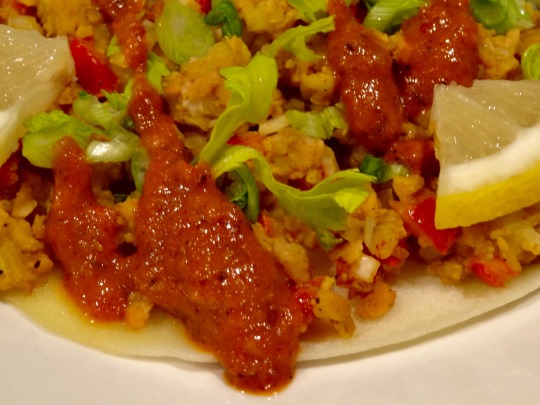
[ID: First image is a thin crèpe topped with ground 'meat,' herbs, and tomato, and garnished with lemon. Second image is a close-up of the same crèpe with a thick red sauce drizzledover it. End ID
𑐔𑐟𑐵𑑄𑐩𑐬𑐶 / चतांमरि / Chatamari (Newari rice crèpe)
𑐔𑐟𑐵𑑄𑐩𑐬𑐶 / चतांमरि (chatā̃mari), sometimes called "Newari pizza," are rice crèpes made plain or with a savory topping. Chatamari are a popular festival food among the indigenous 𑐣𑐾𑐰𑐵𑑅 / नेवा: (Naivāḥ / Newa) people, most of whom live in the 𑐣𑐾𑐥𑐵𑑅 𑐐𑐵𑑅 / नेपाः गाः (Naipāḥ gāḥ / Nepa Valley) in central Nepal. [1] They are regarded as a near-compulsory addition to the table for holidays including 𑐴𑑂𑐩𑐥𑐸𑐖𑐵 / म्ह पूजा (mha pūjā) and 𑐡𑐶𑐐𑐸 𑐥𑐹𑐖𑐵 / दिगु पूजा (digu pūjā), when they are served as snacks and appetizers.
A chatamari consists of a thin, fried crèpe, fluffy on the inside and crispy around the edges, and an optional juicy, well-spiced topping. Common toppings are vegetable (with black-eyed peas, potato, and/or soy chunks); meat (with minced chicken or buffalo and tomato); a cracked egg; or some combination thereof. Ginger, garlic, red onion, cumin, turmeric, and sometimes red chili powder and coriander add bite and aroma. To cook chatamari, a thin layer of batter is spread on a tawa, and the batter is topped; the whole is then covered with a clay conical lid and left to steam.
This recipe is for a 𑐎𑐷𑐩𑐵 / कीमा (kīmā; minced meat) chatamari with potato, but you can try replacing the meat substitute with cooked black-eyed peas, replacing the potato with more meat, or replacing the meat and potato with vegetables of your choice (try green peas, julienned carrots, and green onion)—the basic format of this dish is highly customizable.
The Nepali language is increasingly the language of broadcast, education, and even the home, to the detriment of other languages including the Newa language Nepal Bhasa (𑐣𑐾𑐰𑐵𑑅 𑐨𑐵𑐫𑑂 / नेवा: भाय्, nevāḥ bhāy). Scripts historically used to write Nepal Bhasa and Sanskrit have been almost entirely replaced with Devanagari. 𑐥𑑂𑐬𑐔𑐮𑐶𑐟 / प्रचलित (prachalit; lit. "common") was the script used by literate Newa until it began to decline at the turn of the 20th century; the 1960s governmental policy of सांस्कृतिक एकता (Nepali: sā̃skr̥tik ektā; cultural unity) further marginalized it.
Revival efforts have begun, which claim Prachalit (and the ornamental script Ranjana, also used to write Nepal Bhasa and Sanskrit) as parts of Newa identity, and seek to teach them at fairs and in workshops. A process of "ethnicity-building" and identity formation within Nepal, including pushes to use students' mother tongues as the language of instruction (with Devanagari as a "common" script) and to use minoritized languages in television and radio broadcast, have been ongoing since the 1990s.
[1] Terminology is given in Nepal Bhasa unless otherwise specified, in Prachalit followed by Devanagari script. "𑐔𑐟𑐵𑑄𑐩𑐬𑐶," "𑐡𑐶𑐐𑐸 𑐥𑐹𑐖𑐵," and "𑐎𑐷𑐩𑐵" are my transliterations from Devanagari into Prachalit. Latin transliteration is ISO 15919 standard except: "च" ([t͡ʃə]) is rendered "cha" and not "ca." Where two Latin phrases are given, the first is ISO from Devanagari, and the second is the typical English-language spelling or phrase.
Recipe under the cut!
Patreon | Paypal | Venmo
Ingredients
Makes 4 large.
For the topping:
3/4 cup (74g) textured vegetable protein + 1/2 cup (118mL) broth
Or 1 1/2 cup ground beef substitute of choice
1 russet potato (200g) (optional)
2 roma tomatoes, minced or thinly sliced
1 small red onion, minced or thinly sliced
1 green chili, diced or thinly sliced
1/2-inch chunk (5g) ginger, peeled and grated or pounded
2 cloves garlic, grated or pounded
1 tsp ground coriander
1 tsp ground cumin
1 tsp ground turmeric
1 tsp red chili powder (substitute sweet paprika to reduce spice level)
1 tsp meat masala (optional)
2 Tbsp neutral oil (if not including 'egg')
Cilantro, to top
For the egg (optional):
2 Tbsp yellow mung flour or chickpea flour (besan)
1/4 cup coconut milk
1 tsp kala namak (black salt)
You may also use any other egg substitute. This one is inspired by Vietnamese bánh xèo. The coconut milk provides binding and fat; the final topping will not taste of coconut. You may replace it with any neutral oil.
For the batter:
1 1/2 cup (240g) white rice flour
About 1 1/2 cup (350 mL) cool water
Mustard oil, to fry
The chatamari in the photo is served with achar.
Instructions
For the batter:
1. Measure flour into a bowl. Pour in water slowly while whisking until a smooth, pourable batter (the consistency of crèpe batter) forms. Set aside to rest while making the filling.
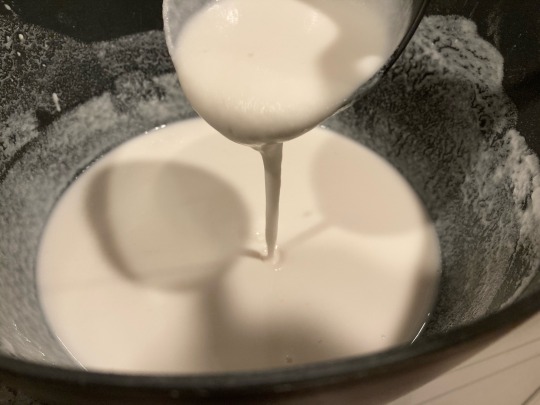
For the filling:
1. Peel and cube potato, then boil until soft. Mash thoroughly with a bean masher or fork.
2. Hydrate TVP in broth or stock (I used water with 1/2 tsp vegetarian beef stock concentrate) for 10 minutes.
3. Mix potato, minced tomatoes and onion, ground 'meat', spices, and 'egg' together in a large mixing bowl until well-combined.
To assemble:
1. Heat a large tawa, comal, or nonstick skillet on medium. Fill a ladle with 100 mL (a bit less than 1/2 cup) of batter, and pour it into the center of the skillet; it should become round on its own. Thin it out a bit with the bottom of the ladle.
2. Cover the top of the batter with the topping, leaving a bit of space on the edge. Optionally, add about 2 tsp of oil around the edges of the chatamari to crisp.
3. Lower the heat to low and cover. Cook for 7 minutes. Remove chatamari onto a plate.
If the rice pancake cracks, your batter is too thin; try resting it, uncovered, for 5-10 minutes, then stirring it and trying again.
4. Raise heat to medium for a minute. Add another ladle of batter, top the chatamari, add oil, lower the heat and cover to cook as before. Repeat until batter or filling runs out.
87 notes
·
View notes
Text
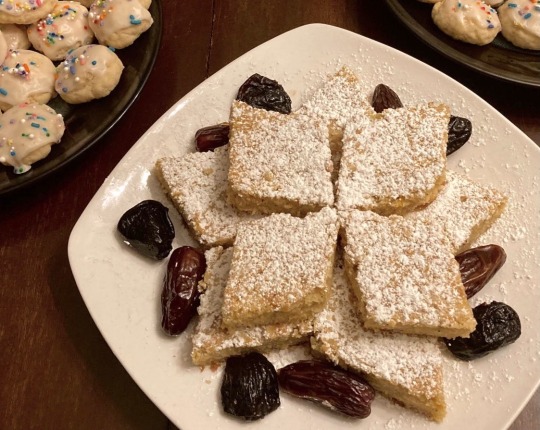
[ID: Diamond-shaped cake slices arranged into a layered star shape, topped with powdered sugar, with dates and prunes placed around the edge of the plate. Two plates of Italian Christmas cookies are in the background. End ID]
Whole orange cake with sumac and pink peppercorn
This moist, flavorful cake is inspired by Sicilian torta all’arancia (orange cake) and Moroccan مَسْكُوتة ("maskūta"). There is no peeling, zesting, or juicing of oranges required; oranges are added whole, and lend the citrus oils in their peels, the sweetness and flavor of their juice, and the tenderness of their pulp to the final cake.
Maskouta is a wheat-flour-based cake that often comes in orange or yoghurt varieties—this recipe combines both versions. The addition of yoghurt makes the cake incredibly tender, and adds a smooth tartness that perfectly balances the brightness, robustness, and slight bitterness of the citrus oils that infuse the cake. Cardamom and orange blossom water, both occasional additions in Moroccan orange cakes, add delicate aromatics that further round out the flavor of the cake; sumac and pink peppercorn add a sour, fizzling touch that draws the brightness of the orange to a head at the front of the palate.
Recipe under the cut!
Patreon | Paypal | Venmo
Ingredients:
2 whole organic oranges
1 3/4 cup (210g) flour
1 1/2 tsp sumac
3/4 tsp pink peppercorn
6 green cardamom pods
1 tsp baking powder
1 tsp baking soda
1 tsp kosher salt
2 tsp orange blossom water
3 Tbsp olive oil
1/3 cup non-dairy yoghurt
1/2 cup non-dairy margarine, softened
1 cup vegetarian granulated sugar
Sicilian and Moroccan orange cakes do not usually include butter; however, I find that a creaming method, which incorporates air into a solid fat such as margarine, helps replace some of the leavening power of whipped eggs.
Instructions:
1. Scrub oranges thoroughly. Submerge them in cool water (weighing them down with a plate) and soak overnight.
This step removes some of the bitterness of the orange peels. If you don't have time for soaking, or if you very much dislike any amount of bitterness in sweets, zest the oranges by taking off just the orange layer of the peel with a microplane or vegetable peeler; set zest aside. Remove as much of the white pith as you can and discard. Use the zest and the peeled orange slices in place of the whole oranges.
2. Remove oranges from water. Blend them, along with orange blossom water, until homogenous. The mixture does not need to be completely liquid.
3. Toast cardamom pods and pink peppercorns in a dry skillet on medium heat until fragrant. Grind in a spice mill, or with a mortar and pestle. Combine dry ingredients (spices, flour, salt, baking powder, and baking soda) in a mixing bowl.
3. Cream margarine in a large mixing bowl with an electric hand mixer for 30 seconds, until fluffy. Add sugar and cream for 2 minutes, until aerated.
3. Gradually add pulverized oranges and fold in. Add olive oil and yoghurt and fold to combine.
4. Slowly add dry ingredients and gently fold until combined. You should get a fairly thick batter.
5. Prepare a 9" x 13" (about 22 x 33 cm) glass cake pan with oil or margarine. Pour in batter and flatten with a rubber spatula.
6. Bake in the bottom of an oven at 350 °F (175 °C) for 50 minutes, or until a toothpick entered into the center of the cake comes out clean.
7. Once cake has cooled, cut into slices and arrange as desired. Top with powdered sugar.
216 notes
·
View notes
Text
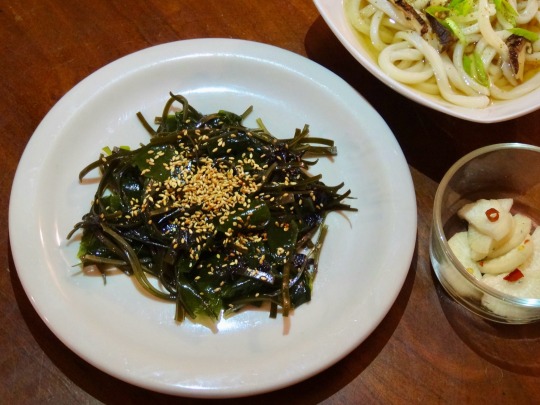

[ID: First photo shows a mixed seaweed salad topped with toasted sesame seeds; in the background are bowls of pickled daikon and kake udon. Second photo is a close-up showing light shining through the seaweed. End ID]
わかめと昆布サラダ / Wakame to konbu sarada (Seaweed and kelp salad)
A wide variety of seaweed-based salads are made by Japanese home cooks. They may contain only a mix of seaweeds and a dressing, but may also feature vegetables including cucumber, carrots, lotus root (レンコン / はす), daikon (だいこん), corn, edamame (枝豆), or onion. Dressings are as varied as cooks, and may be based around sesame oil (ごま油), rice vinegar (米酢), miso paste (みそ / 味噌), ponzu sauce (ポン酢), or mayonnaise (マヨ).
This recipe is a good way to use up reconstituted kombu and wakame that were steeped to make soup stock. It includes instructions for two dressings: one based on rice vinegar and sesame oil, and another with a sesame-mayo base.
"わかめ" or "ワカメ" ("wakame") is likely from "若" ("waka," "young") + "海布" ("me," "seaweed"); it is a particular species of edible seaweed (Undaria pinnatifida) that is farmed in Japan, Korea, and China. It is sometimes called "sea mustard" in English. Without further specification, "wakame" in a culinary context is taken to mean the leaves of the seaweed; these are the same leaves that are eaten in miso soup (みそ汁).
The etymology of "昆布" ("kombu" or "konbu") is unknown. It may be a phonetic Japanese reading of the Middle Chinese "昆布" (Mandarin: "kūnbù") (itself from "綸布" "*krūn pās," "green ribbon" + "cloth"), used to refer to various types of kelp and seaweed. In Japanese, the term refers to any of a few species of edible kelp from the Laminariaceae family.
Dried kombu is steeped to make one type of dashi ("出汁" / "だし"), a stock that is used in various soups and sauces. Once reconstituted, it may be steeped again to make 二番だし ("niban dashi," "second dashi"), sliced and simmered as one ingredient in a 煮物 ("nimono," simmered dish), or roasted and combined with other seaweeds and spices to make 振り掛け ("furikake").
"サラダ" ("sarada") is probably derived from the English "salad."
Note that the "seaweed salad" served at Japanese restaurants in the U.S. is not commonly eaten in Japan. It is shipped out to restaurants and stores pre-packaged, and is made with colored オゴノリ ("ogonori"; "agar" on ingredients lists), きくらげ ("kikurage"; "wood ear mushroom" or "fungus" on ingredients lists), and byproducts of wakame including 茎わかめ ("kukiwakame," wakame stem) and メカブ ("mekabu," wakame sprouts; both listed as "wakame" or "seaweed" on ingredients lists). You may be able to find this salad in the freezer section of your local Asian grocery store. If you want to approximate the texture of this salad at home, try buying some mixture of ogonori, kikurage, kukiwakame, mekabu, モズク ("mokuzu"), and/or ひじき ("hijiki"). Instructions for the dressing are below.
Recipe under the cut!
Patreon | Paypal | Venmo
Ingredients:
For the salad:
2 cups total reconstituted kombu, wakame, hijiki, or other kelp or seaweed
Vegetable additions to seaweed salads are possible and common. Try adding some cucumber, julienned carrots, sliced lotus root, sliked daikon radish, corn, edamame, or sliced onion that's been soaked in plum vinegar for 15 minutes.
If you're including cucumbers, slice them, salt them, allow them to drain in a colander for about 10 minutes, then gently squeeze them of excess liquid, to avoid making your salad watery.
For dressing 1:
1 Tbsp unseasoned rice vinegar (米酢)
1 Tbsp toasted sesame oil (煎りごま油)
1/2 kosher salt
1/2 tsp vegetarian granulated sugar
1/2 tsp Japanese soy sauce (しょうゆ / 醤油) (such as Kikkoman's)
2 tsp toasted sesame seeds (いりごま)
To make U.S. restuarant-style seaweed salad, omit the soy sauce; replace the sugar with high fructose corn syrup; and add a pinch of cayenne pepper, 1/4 tsp of onion powder or yeast extract, and a pinch of MSG.
For dressing 2:
2 Tbsp vegan mayonnaise
1/2 tsp unseasoned rice vinegar (米酢)
1/4 tsp dried ground shiitake mushroom, or vegetarian dashi powder
1/4 tsp vegetarian granulated sugar
Drop of djion mustard
Pinch kosher salt
1 tsp Japanese soy sauce (しょうゆ / 醤油) (such as Kikkoman's)
Drizzle of mirin (みりん)
2 tsp toasted sesame seeds, ground in a mortar and pestle or spice mill
If you eat eggs, you can replace the first five ingredients with 2 Tbsp Kewpie mayo (キューピーマヨ).
For a halal version, replace the mirin with an extra pinch of sugar.
Instructions:
For the salad:
1. Slice kombu into very thin strips. Slice wakame into thin strips, or leave as-is, as desired. Slice other flat dried seaweed into thin strips or bite-sized pieces.
For dressing 1:
1. Whisk all ingredients except sesame seeds together in a small bowl. Toss with seaweed. Top with sesame seeds and serve cold.
For dressing 2:
1. Whisk all ingredients together in a small bowl. Toss with seaweed. Serve cold.
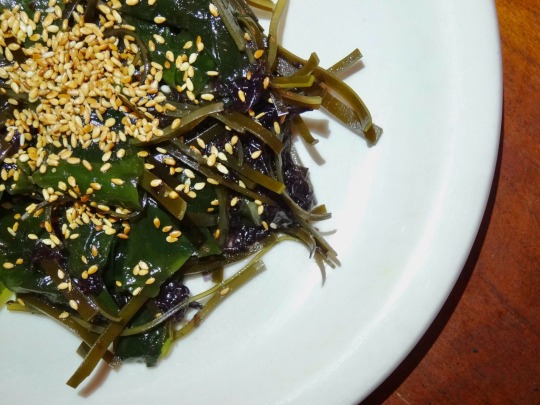
67 notes
·
View notes
Text

[ID: Buttermilk being poured from a Moroccan ceramic cup with orange and black geometric designs into a glass. End ID]
لبن نباتي / Lbn nabati (Vegan traditional buttermilk)
Lbn (لْبْنْ or لْبَنْ; also transliterated "lban") is a Moroccan buttermilk drink. It is not to be confused with standard Arabic لَبَن ("laban"), meaning "milk"; with Levantine لَبَن ("laban"), also called لَبَن رَائِب ("laban ra'ib"), which is curdled milk (a.k.a., yoghurt); or with Levantine لَبْنَة ("labna"), which is yoghurt that has been strained and thickened.
Instead, lbn is a traditional buttermilk. It is historically made the same way Western traditional buttermilk is: by leaving raw milk to sit at room temperature while the cream separates and rises to the top, allowing the cream to ferment, and then churning the cream until it separates further into milk solids (cultured butter) and a cultured liquid byproduct (traditional buttermilk). Commercial Western buttermilk, and some Moroccan lbn, is now no longer traditional buttermilk but instead cultured buttermilk, which is produced by fermenting low-fat milk; this produces a thicker, more acidic liquid than traditional buttermilk. Lbn is usually made with goat's milk, though cow's milk is also often used.
Lbn—very sour and tangy, slightly sweet, and about the consistency of milk—is consumed as a refreshing after-dinner drink during the summer. It is also used to soak كُسْكُس ("couscous") (made from durum, barley, or corn flour). Couscous with lbn is called سَيْكُوك ("saykouk") in Darija (Moroccan Arabic), or أزَيْكُوك ("azaykouk") in Tamazight.
Saykouk is a cold dish, commonly eaten in the desert and in rural areas during the summertime; but it is also sold from food carts and by vendors on bicycles year-round in cities. On Fridays, Moroccans often eat couscous dishes with lbn on the side, and may make some on-the-fly saykouk by pouring lbn into their bowls to soak the couscous that remains after the vegetables or meat in the dish have been eaten.
This recipe resembles cultured buttermilk, in that it ferments non-dairy milk with live cultures to achieve a sour taste. However, it more resembles traditional dairy buttermilk in taste and texture. Note that this lbn is intended for drinking and for recipes that call for Moroccan traditional buttermilk, and not for replacing Western cultured buttermilk in pastries or pancakes.
Recipe under the cut!
Patreon | Paypal | Venmo
Ingredients:
2 cups full-fat oat milk
1-3 vegetarian probiotic capsules (containing at least 10 billion cultures total)
A few pinches salt
A few pinches granulated sugar
Make sure your probiotic capsules contain no prebiotics, as they can interfere with the culture. The probiotic may be multi-strain, but should contain some of: Lactobacillus casei, Lactobacillus rhamnosus, Bifidobacterium bifidus, Lactobacillus acidophilus. The number of capsules you need will depend on how many cultures each capsule is guaranteed to contain.
Instead of probiotic capsules, you can use a specialty starter culture pack intended for use in culturing vegan dairy, many of which are available online. Note that starter cultures may be packaged with small amounts of powdered milk for the bacteria to feed on, and may not be truly vegan.
Other types of non-dairy milk may work. My trial with soy milk did not succeed (it never became notably tangy). Soaked and blended cashews will thicken substantially, so be sure to blend cashews with at least twice their volume in (just-boiled, filtered) water if you want to use cashews as your base. I found that oat milk, as well as being more convenient and cheaper than cashews, more closely mimicked the taste of lbn. I have not tested anything else.
Instructions:
1. Boil several cups of water and use the just-boiled water to rinse your measuring cup, the container you will ferment your lbn in, and a wooden spoon or rubber spatula to stir. Your bowl and stirring implement should be in a non-reactive material such as wood, clay, glass, or silicone.
2. Measure oat milk into a container and open probiotic capsules into it. Stir the powder from the capsules in until well combined.
3. Cover the opening of the container with a cheesecloth or tea towel. Ferment for 24 hours: on the countertop in temperate weather, or in an oven with the light on in cold weather.
Taste the lbn with a clean implement (avoid double-dipping!) to see if it is ready. If it still tastes 'oaty,' continue fermenting for another 1-3 days, tasting every 12 hours, until it is notably tangy.
4. Blend lbn with large pinches of salt and sugar; or put lbn, salt, and sugar in a jar with a lid and shake to combine. Taste and adjust salt and sugar.
5. Store in an airtight container in the refrigerator for up to a week. This lbn will continue to culture slowly in the fridge and will eventually (like dairy lbn) become too sour to drink.
Serve chilled.
#I'm really excited about this one guys I have been racking my brain for a way to make vegan lbn forever!!#but that was before I knew about the power of culturing#Moroccan#cultured#fermented#vegan recipes#vegetarian recipes
77 notes
·
View notes
Text
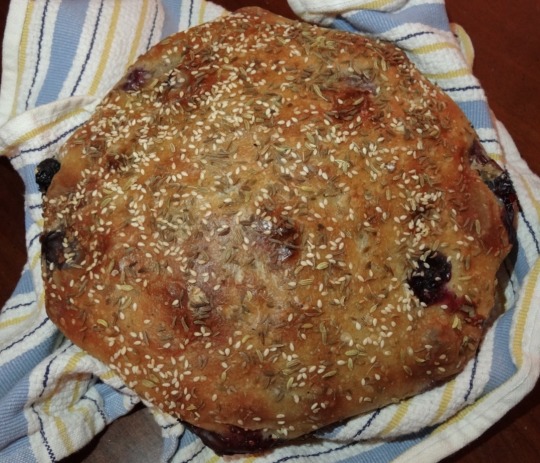
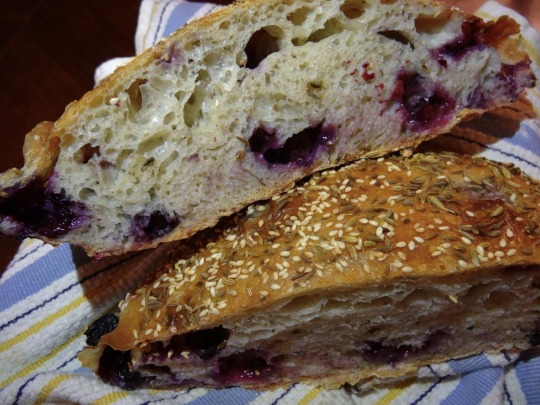
[ID: First image is of a golden brown boule studded with blueberries and covered with seeds; second image shows the boule cut in half to show a holely bread with blueberries throughout. End ID]
Rustic no-knead blueberry bread
This is a crusty, no-knead, sweet-savory bread that pairs blueberries with spices and herbs inspired by West Asian cooking. Fennel, anise, sesame, and mahlab powder are reminiscent of the دُقَّة كَعْك ("duqqa ka'k"; cake powder) used in pastries, while za'tar and caraway skew more savory.
The long rise yields a well-fermented dough with a robust flavor that stands up well against the sweetness and pungency of the fennel and aniseed. The result is a jammy, complex, aromatic boule.
This bread has an open, irregular crumb, great for slicing, toasting, dipping, or spreading. Try it with labna and honey, olive oil and za'tar, or a spreadable cheese. I've also made sandwiches with thick slices of this bread and fried, glazed tofu drizzled with tarator and topped with Iraqi mango pickles, to excellent effect.
Recipe under the cut!
Patreon | Paypal | Venmo
Makes one medium-sized boule.
Ingredients:
3 cups (360g) bread flour
2 tsp kosher salt
1/4 tsp dry active yeast
2 tsp mahlab powder (optional)
1 tsp fennel seed + 1 tsp aniseed, coarsely ground
About 1 2/3 cup water (room temperature)
1/2 cup firm fresh blueberries
1 Tbsp za’tar (wild thyme), crumbled
Additional fennel seeds, aniseed, caraway, and sesame, to top
Mahlab (محلب) powder is the ground-up pits of Mahleb cherries. It can be purchased at a halal or specialty spice store.
Za'tar (wild thyme) can be found in dried form at a halal grocery store. Note that the spice blend, which includes wild thyme, sumac, sesame seeds, and other spices, will also be labelled "za'tar." If you don't have or can't locate any of the herb itself, use any dried woody herb of your choice (e.g. rosemary, thyme, sage), chopped.
Instructions:
1. Making the dough. Measure flour into a large mixing bowl. Add salt, yeast, seeds, and thyme and stir to combine.
2. Gradually add water until a soft, sticky dough forms. You may need more or less than 1 2/3 cup.
3. Flatten dough in the bowl and top with some of the blueberries. Fold the dough to enclose the blueberries, add more blueberries on top, and fold again. Repeat until all blueberries are incorporated.
4. First rise. Shape dough into a ball and place in the bowl seam-side down. Pat the top of the dough with some olive oil and cover the bowl with a kitchen towel. Allow to rest at room temperature for 16-20 hours.
5. Shaping. Gently remove the dough from the bowl and allow it to deflate. Shape the boule by folding an edge in over the center, rotating the dough slightly, and repeating until you have gone all the way around.
6. Flip the ball over so the seam side is down. Place your hands on either side of the dough and then move them down towards the base of the boule, tucking some of the dough under and towards the seam, to tighten the top of the ball. Rotate the ball slightly and do this again, repeating until you've gone all the way around a couple times.
This is the basic method for shaping a boule, lightly adapted to avoid breaking any blueberries. If any of the blueberries start to pop out of the surface of the dough, just press them back in.
7. Second rise. Place your boule on a piece of parchment paper and cover with a kitchen towel. Allow to rise for 1-2 hours, until noticeably puffy.
8. Baking. Place a Dutch oven in your oven and preheat to 450 °F (230 °C). Remove the Dutch oven and place the boule, along with the parchment paper, inside. Put the lid on the Dutch oven and return it to the oven. Bake for 30 minutes.
9. Remove the Dutch oven's lid and bake bread for another 20 minutes, or until the crust is deeply golden brown.
To bake the bread without a Dutch oven, preheat a baking tray in the center of the oven, while preheating a skillet (rated to at least 450 °F) in the bottom; once preheated, transfer the bread and parchment paper to the tray, and pour a few cups of water in the skillet; bake for 30 minutes. Remove the skillet and bake another 20 minutes until golden brown.
Allow the bread to cool completely before cutting into it to avoid creating a mushy texture.
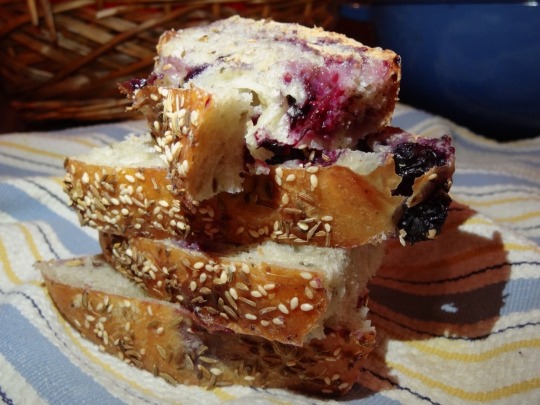
215 notes
·
View notes
Text
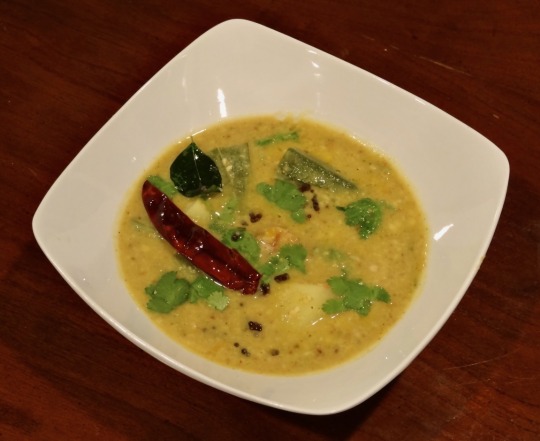
[ID: A bowl of a bright yellow stew topped with cilantro, mustard seed, chili, and curry leaf. End ID]
ಉಡುಪಿ ಸಾಂಬಾರ್ / Udupi sambar
A sambar is a lentil-and-vegetable stew distinguished by the use of a particular spice blend (Hindi: सांबर मसाला "sāmbār masālā," "sambar spice"; Kannada: ಸಾಂಬಾರ್ ಪುಡಿ "sāmbār puḍi," "sambar powder"). Sambars are a staple of South Indian and Sri Lankan cooking, sometimes made in households for multiple meals a week. The word "sambar" can be traced back to the Sanskrit सम्भार "sambhārá," "collection of things required for a particular purpose”; “spices."
The lentil used in sambar dishes is usually tur dal (split pigeon peas), though arhar dal, tuvur dal, or even blends containing masur or mung dal may be used, depending on the cook or the region. Vegetables also vary between combinations of okra, potato, ash gourd (petha), bottle gourd (doodhi / lauki), drumstick (saijan ki phalli), beetroot, tomato, carrot, pumpkin, brinjal, and pearl onions, among others. The sambar masala fries chilis, curry leaves, dal, and various spices including cumin, coriander, and fenugreek, then grinds them into a spicy, earthy, fragrant blend.
This recipe makes a sambar in the style of ಉಡುಪಿ (Udupi) cuisine—a subdivision of the cuisine of the ತುಳುವ (Tuluva) people localised in the Udupi District of Karnataka, a southeastern coastal state of India. (Tuluva cuisine is also commonly found in Dakshina Kannada, Karnataka, and Kasaragod, Kerala). In the Udupi region, sambar may be known as "ಕೊಡೆಲ್" "kodhel"; perhaps related to "ಕಡಲೆ" "kadhale" "Bengal gram"; or "ಹುಲಿ" "huḷi"; "tartness." Udupi huli has coconut oil and jaggery as its primary distinguishing features: the jaggery's deep sweetness and the earthy pungency of unrefined coconut oil combine with the spice of the chilis and the sour fruitiness of the tamarind to create a complex, flavorful, well-balanced dish.
Udupi huli may be further divided into a few major types. ಮಸಾಲೆ ಹುಳಿ ("masāla huḷi") contains shredded coconut and vegetables; ಬೋಳು ಹುಳಿ ("bolu huḷi") contains vegetables, but omits the coconut.
Hotel-style masala huli recipes typically add a lot of jaggery to produce a distinct sweetness; cut back on the amount of coconut included; and contain onion and garlic. The other main type of masala huli—“temple style”—is sattvic (from Sanskrit "सत्त्व" "sattva": "goodness," "essence," "existence"), which in this context means that onions and garlic are excluded.
A sattvic diet in Hinduism centres around the concept of maintaining sattva by eating only pure and mild (sattvic) foods, and omitting tamasic (“dark,” "inert," "destructive"; from Sanskrit तमस् "tamas") and rajasic ("exciting," "passionate," from Sanskrit रजस् "rajas") ones. The concepts of sattva, tamas, and rajas (the गुण "guṇa" system) are central to the construction of caste: the degree to which each person innately inherits each quality supposedly determines their possession of characteristics including honesty, intelligence, and goodness (sattva), stupidity and lack of creativity (tamas), and passion and pridefulness (rajas); the possession of these characteristics in turn determines their rightful place in a professional and social hierarchy. The association of certain foods with certain qualities thus links diet to caste: a distinction in diet is one of the methods by which those belonging to upper castes maintain and police caste boundaries.
This recipe makes enough pudi for one pot of sambar. Traditionally, sambar pudi is created fresh each time the dish is made, but many households make large batches and store them. In this case, omit the coconut; or, use dried coconut and store the masala in the refrigerator.
Recipe under the cut!
Patreon | Paypal | Venmo
Ingredients:
Serves 4-6.
For the sambar:
2 cups chopped vegetables
1 red onion, sliced*
1 cup (200g) yellow split pigeon peas / tur dal / ತೂರ್ ದಾಲ್ (ಹಳದಿ ಸ್ಪ್ಲಿಟ್ ಪಾರಿವಾಳದ ಬಟಾಣಿ)
4 cups (1 litre) water, or as needed
1/4 tsp ground turmeric / haldi / ಅರಿಶಿನ
2 tsp table salt
2 tsp jaggery / gur / ಬೆಲ್ಲ*
1/4 cup (60mL) tamarind pulp (from 1 Tbsp dried tamarind / imlie / ಹುಣಸೆಹಣ್ಣು)
2 tsp unrefined coconut oil / nariyal ka tel / ತೆಂಗಿನ ಎಣ್ಣೆ
Ingredient list format is English / Hindi (Latin transcription) / Kannada. The Hindi is provided for convenience while shopping.
Udupi sambar usually uses any of: gourd, brinjal (Indian eggplant), pumpkin, dumstick (saijan ki phalli), and okra. Pearl onion is not usually used in this region, but you can add whatever you want, according to taste.
*For a hotel-style sambar, include the onion; increase the jaggery to 2 Tbsp.
For the spice paste / sambar masala / ಸಾಂಬಾರ್ ಪುಡಿ ("sambar pudi"):
1/2 Tbsp split Bengal gram / chana dal / ಹಳದಿ ಸ್ಪ್ಲಿಟ್ ಗ್ರಾಂ
2 tsp split black gram / urad dal chilka / ಸ್ಪ್ಲಿಟ್ ಬ್ಲ್ಯಾಕ್ ಗ್ರಾಂ
2 tsp coriander seeds / dhaniya / ಕೊತ್ತಂಬರಿ ಬೀಜದ
1/2 tsp fenugreek seeds / methi / ಮೆಂತ್ಯ
1 tsp cumin seeds / jeera / ಜೀರಿಗೆ
1 tsp ground turmeric
5-6 curry leaves / kari pati / ಕರಿಬೇವು
3-4 Byadagi or other dried red chilis / byadagi mirch / ಬ್ಯಾಡಗಿ ಮೆಣಸಿನಕಾಯಿ
4 cloves garlic, skins on*
Large pinch asafoetida / hing / ಇಂಗು
1 cup (100g) fresh coconut (about one coconut)*
1/2 cup (120mL) water
While the ratio of ingredients in Udupi sambar pudi vary slightly, the ingredients themselves are almost always consistent.
*For a hotel-style sambar, include the garlic, and decrease the coconut in the sambar masala to 1/4 or 1/2 cup (25-50g).
The grams and pulses in this pudi have many different names. You can find them in a halal or South Asian grocery store; look on the bag for the Hindi names (since they have been transcribed into Latin, the spelling may vary from what you see here).
The urad dal you find may be husked, and thus yellow instead of black; these will work just as well.
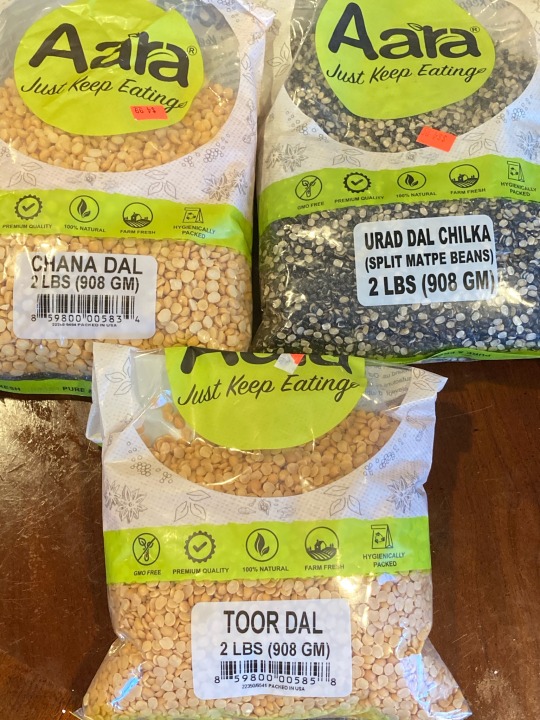
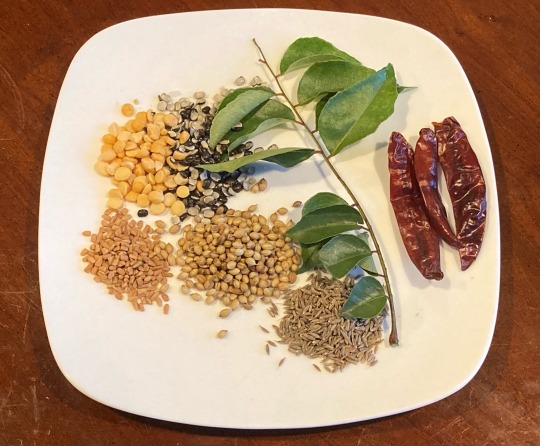
For the tempering / tadka / ಹದಗೊಳಿಸುವ:
2 Tbsp unrefined coconut oil
2 red chilis
8 curry leaves
1 tsp brown mustard seeds / rai / ಸಾಸಿವೆ ಬೀಜಗಳು
Recipes from north Karnataka may add cumin and whole, unpeeled garlic cloves to the tempering.
Instructions:
For the sambar pudi:
1. Break open the coconut and remove and shread its flesh.
If using a whole dried coconut, break into the shell with the wrong side of a hammer and pry open. Break into a few smaller pieces and peel with a vegetable peeler until the skin is removed from the white flesh, wearing something to protect your hand. Soak in warm water for several minutes to soften, and then grate or food process.

2. Heat 2 Tbsp of coconut oil in a skillet on medium-low. Add asafoetida and fry for 30 seconds, until no longer raw-smelling. Add dal and fry, stirring often, for 30 seconds until golden brown; add coriander, mustard, fenugreek, and cumin seeds and fry until fragrant.
3. Add curry leaves and fry until wilted, then add garlic and dried chilis and fry another 30 seconds to a minute, until fragrant.
4. Add coconut and fry, stirring often, for another few minutes until a shade darker. Add turmeric and stir.
5. Grind all ingredients into a paste in a mortar and pestle, then mix in about 1/2 cup water to loosen (if using dried coconut, you may need more water).
Or, put all ingredients along with 1/2 cup water into a blender or food processor and process until a relatively smooth paste forms.
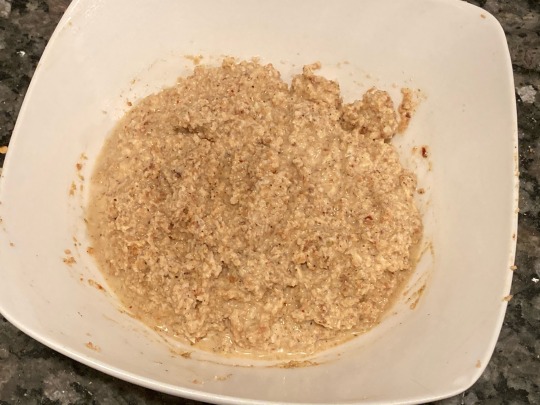
For the sambar:
1. Wash tur dal to remove excess starch. Simmer dal with 2 cups water, 1/4 tsp ground turmeric, and 1 tsp coconut oil for about 30 minutes until very tender. Mash until relatively smooth with a wooden spoon or bean masher, or process briefly with an immersion blender.
You may soak the dal in water after rinsing them to reduce the cooking time, but it is not necessary.
2. Meanwhile, make the tamarind paste. Soak 1 Tbsp tamarind dried pulp in 1/4 cup hot water for 20-30 minutes. Squeeze the tamarind into the water to extract the pulp. Discard the tamarind seeds and husk. Optionally, depending on your preferred texture, push the mixture through a metal sieve.
3. Prepare vegetables. Slice the onion; remove ends of okra and drumsticks and cut into 2-inch pieces; quarter tomatoes; quarter brinjal; peel pumpkin and cut into cubes; peel and cube potatoes.
4. If using onion, add a teaspoon of coconut oil to a large pot and fry until translucent.
5. In the same pot, boil vegetables in just enough water to cover, along with a pinch of salt, until they are beginning to soften.
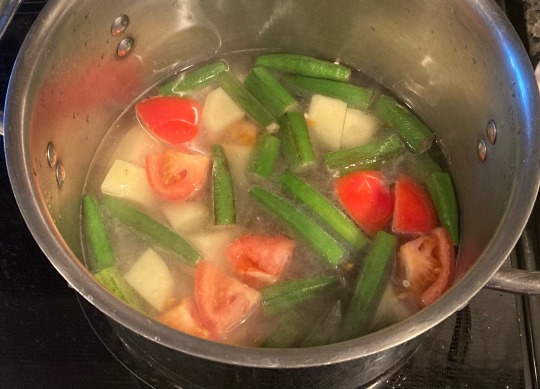
Some recipes call for the vegetables to be boiled, and others call for them to be steamed. I prefer boiling, since it produces a nice savory broth.
6. Mix vegetables, dal, tamarind, jaggery, sambar pudi, and salt to taste and simmer 5-10 minutes to allow flavors to combine and vegetables to cook under tender. Add water as needed. Remove from heat and stir in cilantro. Taste and adjust salt.
The final sambar should be pourable, like a thick soup—Karnataka sambar is typically thinner in consistency than Tamil Nadu versions.
For the tadka:
1. Heat coconut oil in a small skillet on medium heat. Add tempering ingredients and fry, stirring often, until chilis and curry leaves are a couple shades darker and the mixture is fragrant.
2. Pour the oil and tempering ingredients into the sambar and stir in. If you like, retain some of the tadka as a garnish to serve.
3. Serve warm, in individual bowls, alongside long-grain white rice. To eat drumsticks, scoop the center out and eat it; the tough outer rind is left.
If you intend to save some sambar, it's a good idea to make just enough tadka for what you plan to eat that day, and then make fresh tadka to pour over the reheated leftovers.
106 notes
·
View notes
Text
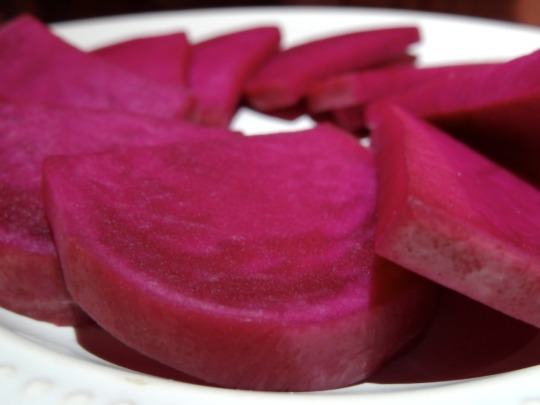
[ID: A circle of overlapping semi-circular bright pink pickles arranged on a plate, viewed from a low angle. End ID]
مخلل اللفت / Mukhallal al-lifit (Pickled turnips)
The word "مُخَلَّل" ("mukhallal") is derived from the verb "خَلَّلَ" ("khallala"), meaning "to preserve in vinegar." "Lifit" (with diacritics, Levantine pronunciation: "لِفِتْ"), "turnip," comes from the root "ل ف ت", which produces words relating to being crooked, turning aside, and twisting (such as "لَفَتَ" "lafata," "to twist, to wring"). This root was being used to produce a word meaning "turnip" ("لِفْتْ" "lift") by the 1000s AD, perhaps because turnips must be twisted or wrung out of the ground.
Pickling as a method of preserving produce so that it can be eaten out of season is of ancient origin. In the modern-day Levant, pickles (called "طَرَاشِيّ" "ṭarāshiyy"; singular "طُرْشِيّ" "ṭurshiyy") make up an important culinary category: peppers, carrot, olives, eggplant, cucumber, cabbage, cauliflower, and lemons are preserved with vinegar or brine for later consumption.
Pickled turnips are perhaps the most commonly consumed pickles in the Levant. They are traditionally prepared during the turnip harvest in the winter; in the early spring, once they have finished their slow fermentation, they may be added to appetizer spreads, served as a side with breakfast, lunch, or dinner, eaten on their own as a snack, or used to add pungency to salads, sandwiches, and wraps (such as shawarma or falafel). Tarashiyy are especially popular among Muslim Palestinians during the holy month of رَمَضَان (Ramaḍān), when they are considered a must-have on the إِفْطَار ("ʔifṭār"; fast-breaking meal) table. Pickle vendors and factories will often hire additional workers in the time leading up to Ramadan in order to keep up with increased demand.
In its simplest instantiation, mukhallal al-lifit combines turnips, beetroot (for color), water, salt, and time: a process of anaerobic lacto-fermentation produces a deep transformation in flavor and a sour, earthy, tender-crisp pickle. Some recipes instead pickle the turnips in vinegar, which produces a sharp, acidic taste. A pink dye (صِبْغَة مُخَلَّل زَهْرِي; "ṣibgha mukhallal zahri") may be added to improve the color. Palestinian recipes in particular sometimes call for garlic and green chili peppers. This recipe is for a "slow pickle" made with brine: thick slices of turnip are fermented at room temperature for about three weeks to produce a tangy, slightly bitter pickle with astringency and zest reminiscent of horseradish.
Turnips are a widely cultivated crop in Palestine, but, though they make a very popular pickle, they are seldom consumed fresh. One Palestinian dish, mostly prepared in Hebron, that does not call for their fermentation is مُحَشّي لِفِتْ ("muḥashshi lifit")—turnips that are cored, fried, and stuffed with a filling made from ground meat, rice, tomato, and sumac or tamarind. In Nablus, tahina and lemon juice may be added to the meat and rice. A similar dish exists in Jordan.
Turnips produced in the West Bank are typically planted in open fields (as opposed to in or under structures such as plastic tunnels) in November and harvested in February, making them a fall/winter crop. Because most of them are irrigated (rather than rain-fed), their yield is severely limited by the Israeli military's siphoning off of water from Palestine's natural aquifers to settlers and their farms.
Israeli military order 92, issued on August 15th, 1967 (just two months after the order by which Israel had claimed full military, legislative, executive, and judicial control of the West Bank on June 7th), placed all authority over water resources in the hands of an Israeli official. Military order 158, issued on November 19th of the same year, declared that no one could establish, own, or administer any water extraction or processing construction (such as wells, water purification plants, or rainwater collecting cisterns) without a new permit. Water infrastructure could be searched for, confiscated, or destroyed at will of the Israeli military. This order de facto forbid Palestinians from owning or constructing any new water infrastructure, since anyone could be denied a permit without reason; to date, no West Bank Palestinian has ever been granted a permit to construct a well to collect water from an aquifer.
Nearly 30 years later, the Interim Agreement on the West Bank and the Gaza Strip (also called the Oslo II Accord or the Taba Agreement), signed by Israel and the Palestine Liberation Organization (PLO) in 1995, officially granted Israel the full control over water resources in occupied Palestine that it had earlier claimed. The Argreement divided the West Bank into regions of three types—A, B, and C—with Israel given control of Area C, and the Palestinian Authority (PA) supposedly having full administrative power over Area A (about 3% of the West Bank at the time).
In fact, per article 40 of Annex 3, the PA was only allowed to administer water distribution in Area A, so long as their water usage did not exceed what had been allocated to them in the 1993 Oslo Accord, a mere 15% of the total water supply: they had no administrative control over water resources, all of which were owned and administered by Israel. This interim agreement was to be returned to in permanent status negotiations which never occurred.
The cumulative effect of these resolutions is that Palestinians have no independent access to water: they are forbidden to collect water from underground aquifers, the Jordan River, freshwater springs, or rainfall. They are, by law and by design, fully reliant on Israel's grid, which distributes water very unevenly; a 2023 report estimated that Israeli settlers (in "Israel" and in the occupied West Bank) used 3 times as much water as Palestinians. Oslo II estimations of Palestinians' water needs were set at a static number of million cubic meters (mcm), rather than an amount of water per person, and this number has been adhered to despite subsequent growth in the Palestinian population.
Palestinians who are connected to the Israeli grid may open their taps only to find them dry (for as long as a month at a time, in بَيْت لَحْم "bayt laḥm"; Bethlehem, and الخَلِيل "al-khalīl"; Hebron). Families rush to complete chores that require water the moment they discover the taps are running. Those in rural areas rely on cisterns and wells that they are forbidden to deepen; new wells and reservoirs that they build are demolished in the hundreds by the Israeli military. Water deficits must be made up by paying steep prices for additional tankards of water, both through clandestine networks and from Israel itself. As climate change makes summers hotter and longer, the crisis worsens.
By contrast, Israeli settlers use water at will. Israel, as the sole authority over water resources, has the power to transfer water between aquifers; in practice, it uses this authority to divert water from the Jordan River basin, subterranean aquifers, and بُحَيْرَة طَبَرِيَّا ("buḥayrat ṭabariyyā"; Lake Tiberias) into its national water carrier (built in 1964), and from there to other regions, including the Negev Desert (south of the West Bank) and settlements within the West Bank.
Whenever Israel annexes new land, settlers there are rapidly given access to water; the PA, however, is forbidden to transport water from one area of the West Bank to another. Israel's control over water resources is an important part of the settler colonial project, as access to water greatly influences the desirability of land and the expected profit to be gained through its agricultural exports.
The result of the diversion of water is to increase the salinity of the Eastern Aquifer (in the West Bank, on the east bank of the Jordan River) and the remainder of the Jordan that flows into the West Bank, reducing the water's suitability for drinking and irrigation; in addition, natural springs and wells in Palestine have run dry. In this environment, water for drinking and watering crops and livestock is given priority, and many Palestinians struggle to access enough water to shower or wash clothing regularly. In extreme circumstances, crops may be left for dead, as Palestinian farmers instead seek out jobs tending Israeli fields.
Some areas in Palestine are worse off in this regard than others. Though water can be produced more easily in the قَلْقِيلية (Qalqilya), طُولْكَرْم (Tulkarm) and أَرِيحَا ("ʔarīḥā"; Jericho) Districts than in others, the PA is not permitted to transfer water from these areas to areas where water is scarcer, such as the Bethlehem and Al-Khalil Districts. In Al-Khalil, where almost a third of Palestinian acreage devoted to turnips is located [1], and where farming families such as the Jabars cultivate them for market, water usage averaged just 51 liters per person per day in 2020—compare this to the West Bank Palestinian average of 82.4 liters, the WHO recommended daily minimum of 100 liters, and the Israeli average of 247 liters per person per day.
As Israeli settlement גִּבְעַת חַרְסִינָה (Givat Harsina) encroached on Al-Khalil in 2001, with a subdivision being built over the bulldozed Jabar orchard, the Jabars reported settlers breaking their windows, destroying their garden, throwing rocks, and holding rallies on the road leading to their house. In 2010, with the growth of the קִרְיַת־אַרְבַּע (Kiryat Arba) settlement (officially the parent settlement of Givat Harsina), the Jabars' entire irrigation system was repeatedly torn out, with the justification that they were stealing water from the Israeli water authority; the destruction continued into 2014. Efforts at connecting and expanding Israeli settlements in the Bethlehem area continue to this day.
Thus we can see that water deprivation is one tool among many used to drive Palestinians from their land; and that it is connected to a strategy of rendering agriculture impossible or unprofitable for them, forcing them into a state of dependence on the Israeli economy.
Turnips, as well as cabbage and chili peppers, are also grown in the village of وَادِي فُوقِين (Wadi Fuqin), west of Bethlehem. In 2014, Israel annexed about 1,250 acres of land in Wadi Fuqin, or a third of the village's land, "effectively [ruling] out development of the village and its use of this land for agriculture." Most of this land lies immediately to the west of a group of settlements Israel calls גּוּשׁ עֶצְיוֹן ("Gush Etzion"; Etzion Bloc). Building here would link several non-contiguous Israeli settlements with each other and with القدس (Al-Quds; "Jerusalem"), hemming Palestinians of the region in on all sides (many main roads through Israeli settlements cannot be used by anyone with a Palestinian ID). [2] PLO executive committee member Hanan Ashrawi said that the annexation, which was carried out "[u]nder the cover of [Israel's] latest campaign of aggression in Gaza," "represent[ed] Israel’s deliberate intent to wipe out any Palestinian presence on the land".
This, of course, was not the beginning of this strategy: untreated sewage from Gush Etzion settlements had been contaminating crops, springs, and groundwater in Wadi Fuqin since 2006, which also saw nearly 100 acres of Palestinian land annexed to allow for expansion of the Etzion Bloc.
All of this has obviously had an effect on Palestinian agriculture. A 1945–6 British survey of vegetable production in Palestine found that 992 dunums were devoted to Arab turnip production (954 irrigated and 38 rain-fed; no turnip production was attributed to Jewish settlers). A March 1948 UN report claimed that "[i]n most districts the markets are well-supplied with all the common winter vegetables—cabbages, cauliflowers, lettuce and spinach; carrots, turnips and and beets; beans and peas; green onions, eggplants, marrows and tomatoes." By 2009, however, the area given to turnips in Palestine had fallen to 918 dunums. Of these, 864 dunums were irrigated and 54 rain-fed. This represents an increase in unirrigated turnips (5.8%, up from 3.9%) that is perhaps related to difficulty in obtaining sufficient water.
Meanwhile, Israel profits from its restriction of Palestinian agriculture; it is the largest exporter of turnips in West Asia (I found no data for turnip exports from Palestine after 1922, suggesting that the produce is all for local consumption).
The pattern that Ashrawi called out in 2014 continued in 2023, as Israel's genocide in Gaza occurs alongside the continued and escalating killing and expulsion of West Bank Palestinians. The 2014 annexations, which represented the largest land grab for over 30 years and which appeared to institute a new era of state policy, have been followed up in subsequent years with more land claims and settlement-building.
Israeli military and settler raids and massacres in the West Bank, which had already killed 248 in 2023 before the حَمَاس (Hamas) October 7 offensive had taken place, accelerated after the attack, with forced expulsions of Palestinians (including Bedouin Arabs), and harassment, raids, kidnappings, and torture of Palestinians by a military armed with rifles, tanks, and drones. This violence has been opposed by armed resistance groups, who defend refugee camps from military raids with strategies including the use of improvised explosives.
Support Palestinian resistance by buying an e-sim for distribution in Gaza; donating to help two Gazans receive medical care; or donating to help a family leave Gaza.
[1] 918 dunums were devoted to turnips according to the Palestinian Central Bureau of Statistics (PCBS) report for 2009; the 2008 PCBS report attributes 253 dunums of turnip cultivation to Al-Khalil ("Hebron") for 2006–7.
[2] Today, Gush Etzion is connected to Al-Quds by an underground road that runs beneath the Palestinian Christian town of بَيتْ جَالَا (Bayt Jala).
Ingredients:
Makes 2 1-liter mason jars.
500g (4 medium) turnips
1 beetroot
1 medium green chili pepper (فلفل حار خضرة), halved
2 small cloves garlic, peeled
1 liter (4 cups) distilled or filtered water
25g coarse sea salt (or substitute an equivalent weight of any salt without iodine)
Some brining recipes for lifit call for the addition of a spoonful of sugar. This will increase the activity of lactic-acid-producing bacteria at the beginning of the fermentation, producing a quicker fermentation and a different, sourer flavor profile.
Instructions:
1. Clean two large mason jars thoroughly in hot water (there is no need to sterilize them).
2. Scrub vegetables thoroughly. Cut the top (root) and bottom off of each turnip. Cut each turnip in half (from root end to bottom), and then in 1 cm (1/2") slices (perpendicular to the last cut). Prepare the beetroot the same way.
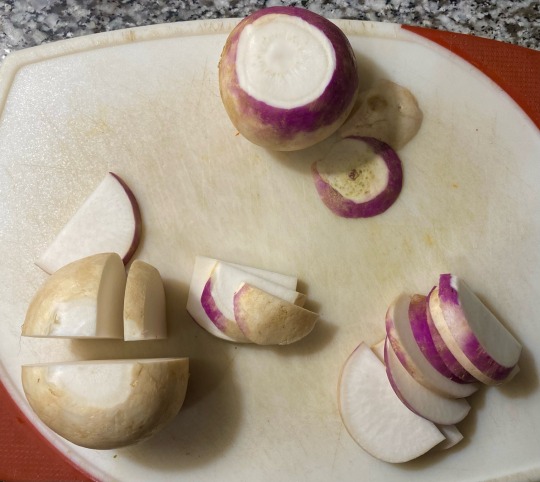
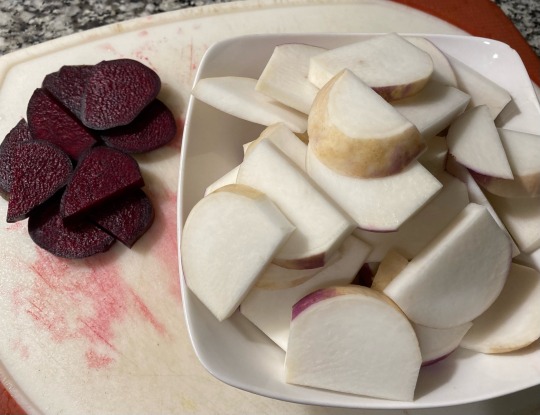
If you need your pickles to be finished sooner, cut the turnips into thinner slices, or into thick (1/2") baton shapes; these will need to be fermented for about a week.
3. Arrange turnip and beet slices so that they lie flat in your jars. Add garlic and peppers.
4. Whisk salt into water until dissolved and pour over the turnips until they are fully submerged. Seal with the jar's lid and leave in a cool place, or the refrigerator, for 20–24 days.

The amount of brine that you will need to cover the top of the vegetables will depend on the shape of your jar. If you add more water, make sure that you add more salt in the same ratio.

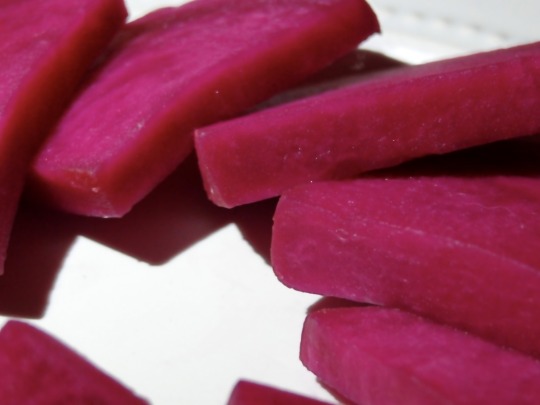
289 notes
·
View notes